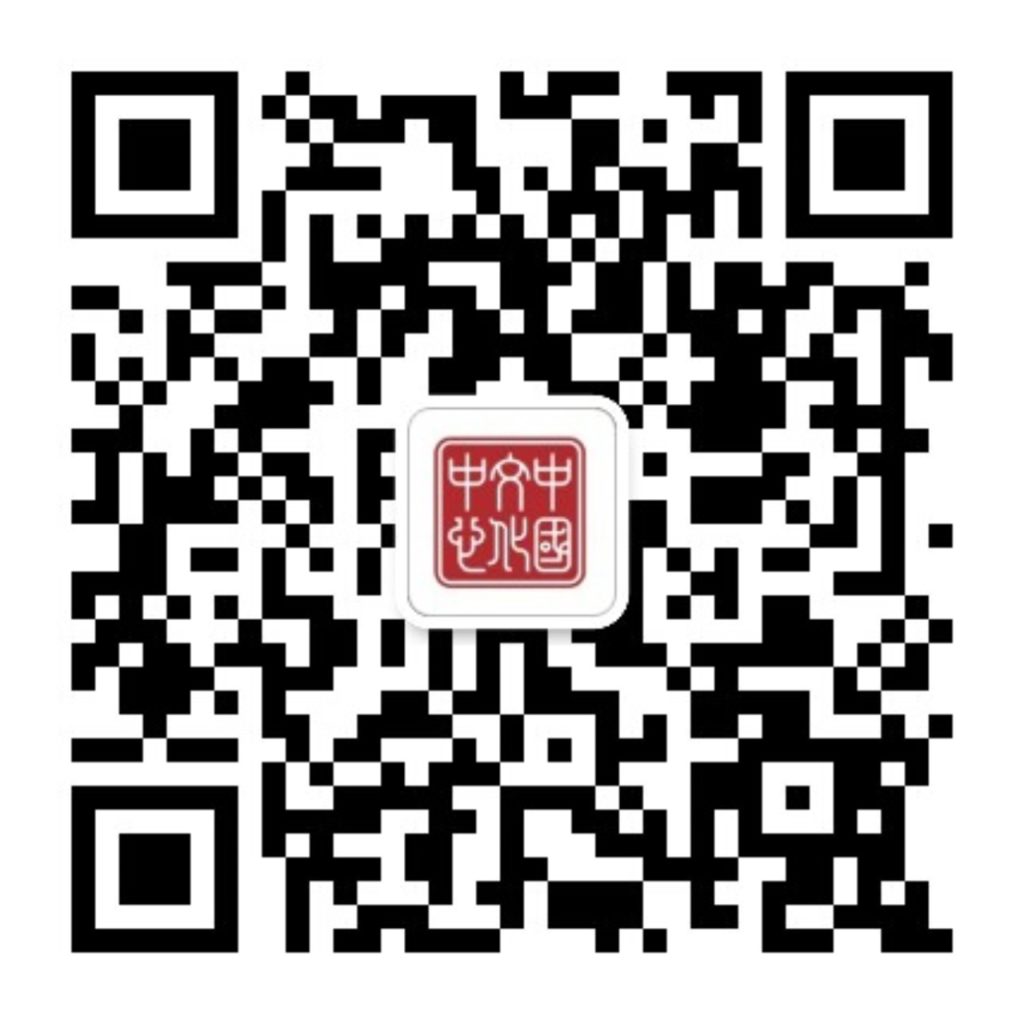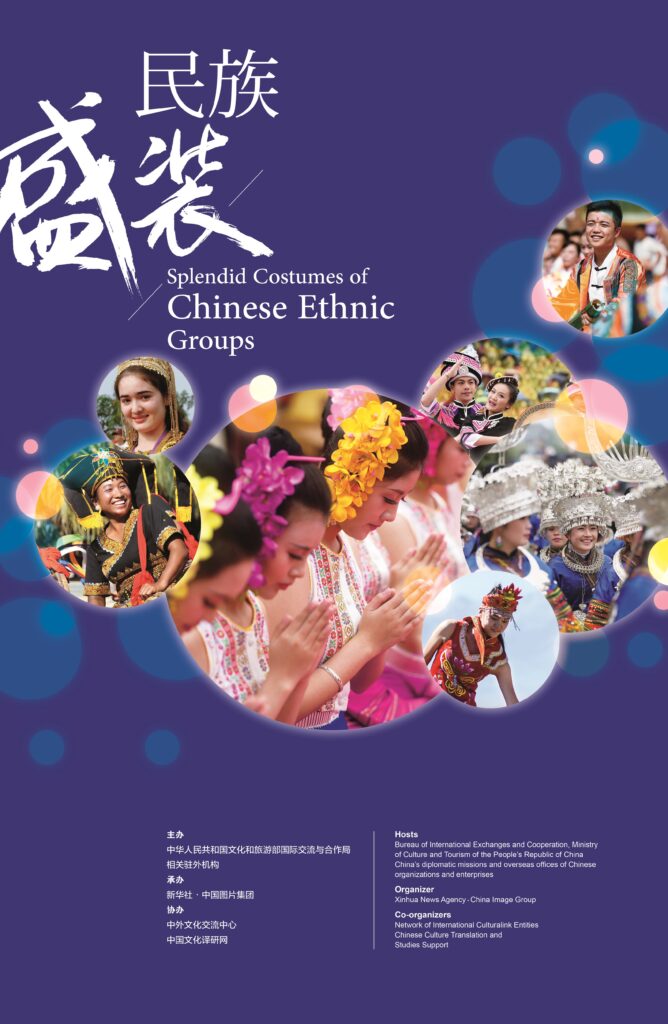
服饰是人类生活的要素之一,也是人类文明的标志之一。作为一种社会文化形态,服饰既是物质文明的结晶,又具精神文明的象征。从衣以遮体的那天起,人们就已经将自己的生活习俗、审美情趣、色彩爱好、文化心态以及宗教观念沉淀于服饰之中。中国是一个由56个民族组成的大家庭,各具特色的民族服饰如同56抹靓丽的色彩,闪耀在神州大地,共同绘制了中国服饰文化的崭新图景。
雅致的汉族汉服、粗犷的蒙族袍服、惊艳的苗族头饰、精致的彝族刺绣、艳丽的壮族织物、夺目的哈萨克族“塔克亚”、七彩的土族花袖、神秘的撒拉族“盖头”、奇异的德昂族腰箍……本展通过中国多彩绚烂的民族盛装,为您呈现中华民族的历史变迁、经济发展和文化演进,展示民族和睦、文化各美其美的和谐中国景象。
Clothing is a key element of human life and a symbol of human civilization. As a representation of society and culture, clothing not only shows material civilization, but also symbolizes spiritual civilization. Since the day when clothes were put over the body, people have already embedded in them their lifestyle and customs, aesthetic taste, preference of colors, cultural mentality, and religious concepts. China is a big family composed of 56 ethnie groups. Their costumes, each with its own characteristics, shine across the wonderful land of China like 56 strokes of beautiful colors, drawing together a new picture of Chinese costume.
The elegant Han costume, the rough Mongolian robe, the stunning Miao headgear, the delicate Yi embroidery, the gorgeous Zhuang fabric, the dazzling Kazakh hat, the multicolored Tu sleeves, the mysterious Salar hijab, the extraordinary De’ang waist band, etc. With splendid costumes of Chinese ethnic groups, this exhibition presents to visitors a magnificent picture of the historical changes, economic development, and cultural evolution of the Chinese nation, showcasing a harmonious China whose ethnic groups stand in unity and whose culture preserved in diversity.
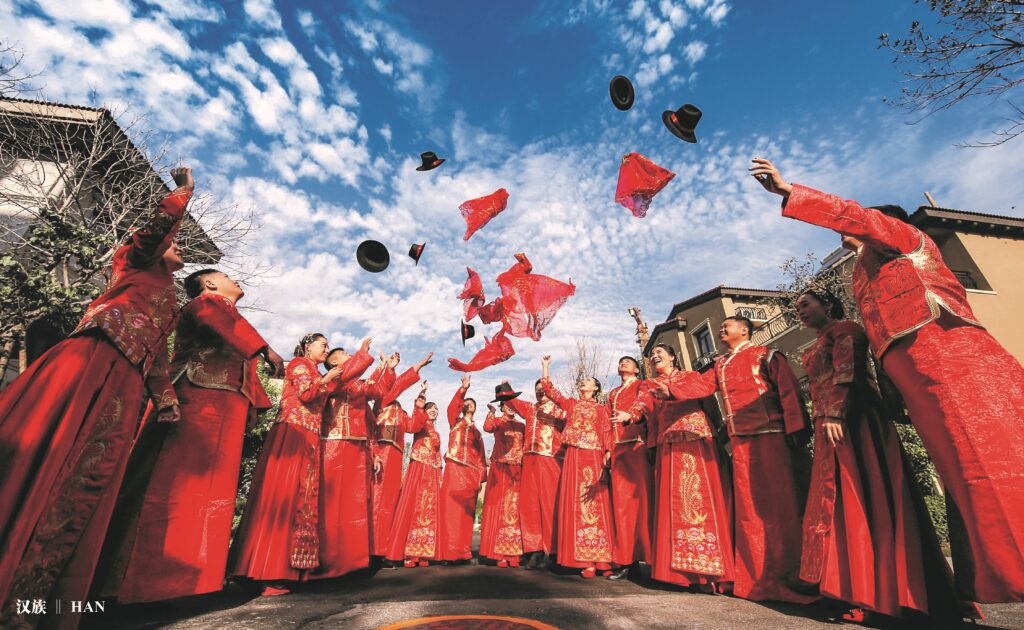
汉族人口由历史上多个地区的多个民族迁徙、融合、交融形成,拥有十分复杂的文化信仰体系。其中历史各朝传统文化主要以儒家、道家、佛家三种信仰为核心,崇尚文雅、节制、绚丽与包容,历史上的宫廷、贵族、民间均有丰富多彩的服装和服饰,工艺亦多种多样。汉族喜爱红色,常以红色作为节庆服装主色。其中宽袍大袖、交领右衽、拥有两千多年历史的“汉服”不仅常见于古装影视剧中,在当代生活中也深受喜爱。(新华社发 刘勤利 摄)
The Han population is formed during the course of history by the migration, assimilation and integration of multiple ethnic groups from multiple regions, and has a very complex system of cultural beliefs. For most of dynasties, the traditional culture is mainly centered on three beliefs: Confucianism, Taoism, and Buddhism, advocating elegance, moderation, magnificence, and inclusiveness. In the history, the court, the nobility, and the folk all have rich and colorful costumes and accessories made with various techniques. The Han people love red and often use it as the main color of the festival costumes. Han costume is a wide robe with big sleeves, with the collars diagonally crossing each other and the right lapel underneath the left. With a history of more than 2000 years, it is not only commonly seen in costume films and TV dramas, but also deeply loved in contemporary life. (Photo by Liu Qinli, Xinhua News Agency)
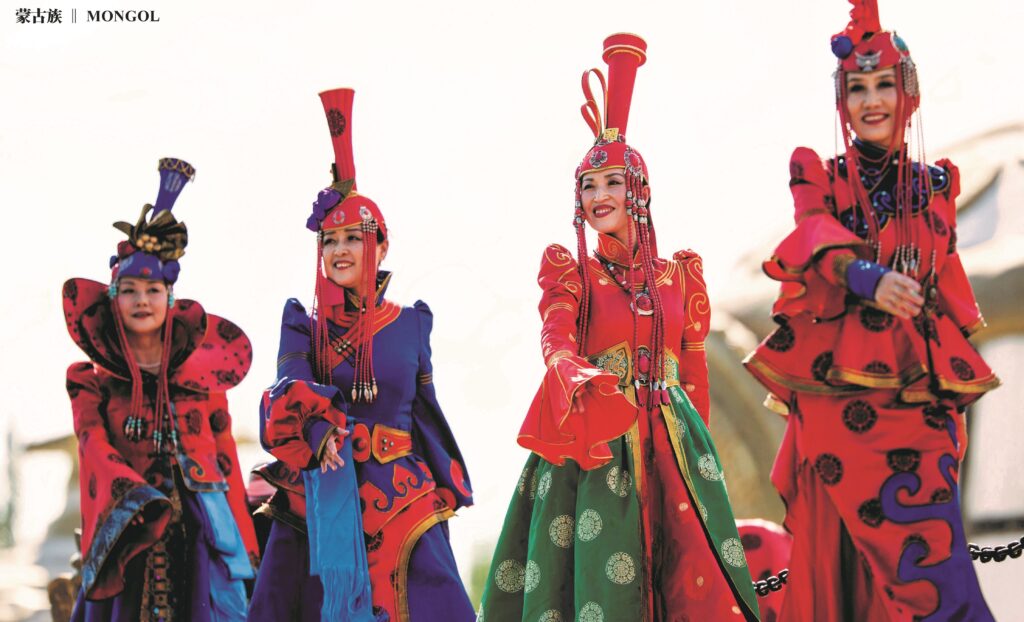
中国的蒙古族主要聚居在内蒙古自治区,传统信仰包括萨满教、佛教、回教。蒙古族人民世居草原,长期以来一直过着“逐水草而居”的游牧生活,他们能歌善舞,其传统服饰也具有浓郁的草原风格,以袍服为主,便于鞍马骑乘,袍装颜色鲜艳,袍身肥大,以红、绿绸缎做腰带。(新华社发 丁根厚 摄)
The Mongolian people in China live mainly in the Inner Mongolia Autonomous Region. Their traditional beliefs include Shamanism, Buddhism, and Islam. The Mongolian people have been living on the grassland for generations, leading a nomadic life of “following water and grass”. They are good at singing and dancing, and their traditional costume has a strong grassland touch – predominantly robes that are comfortable to wear on horses, with vivid colors, broad silhouettes, and red or green belts made of silk or satin. (Photo by Ding Genhou, Xinhua News Agency)
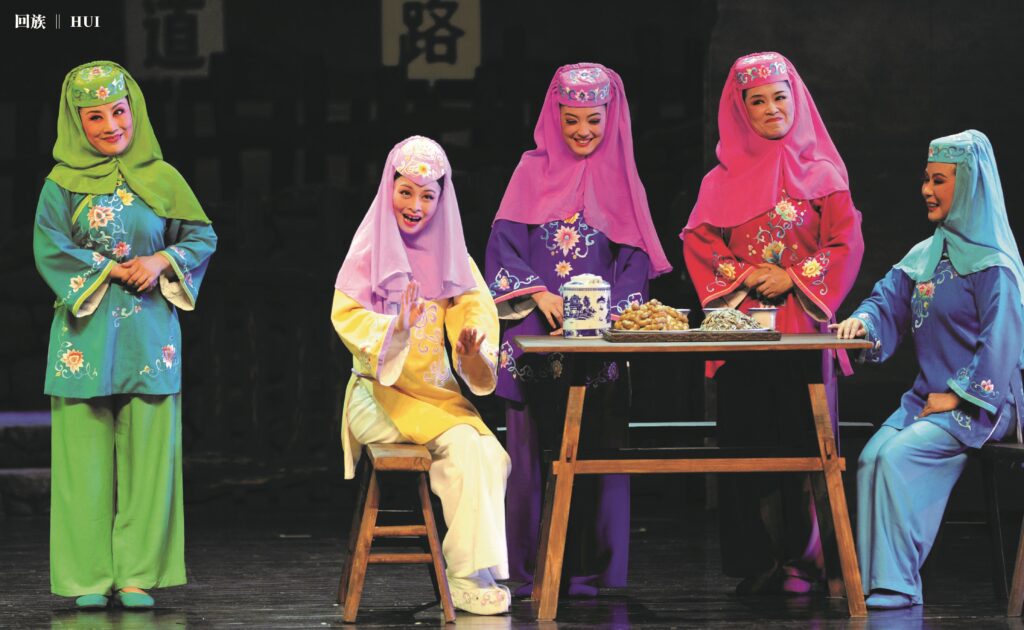
回族在中国的分布格局为“大分散、小聚居”,宁夏回族自治区是其主要聚居区。回族人民历史上多信仰伊斯兰教,但亦融入了丰富的本地色彩,实现了本地化的转变。以头饰为例,回族男子通常戴白色圆帽,但亦喜爱加上绣花等装饰,女子通常戴盖头,多选用鲜艳自然的色彩,材质亦从丝、绸到乔其纱等充满变化,体现着浓厚的中国特色和世俗特征。(新华社记者 王颂 摄)
In China, the Hui people are “largely scattered in small compact communities”. They inhabit mainly the Ningxia Hui Autonomous Region. In the past, they believed in Islam, but have localized the religion by adding rich local colors to it. Take the headgear as an example. Men of the Hui ethnic group usually wear white round caps, but like to add embroidery and other decorations. Women often wear hijabs, but tend to choose bright and natural colors. The material varies from silk, satin to crepe georgette, reflecting strong features that are considered Chinese or secular. (Photo by Wang Song, journalist of Xinhua News Agency)
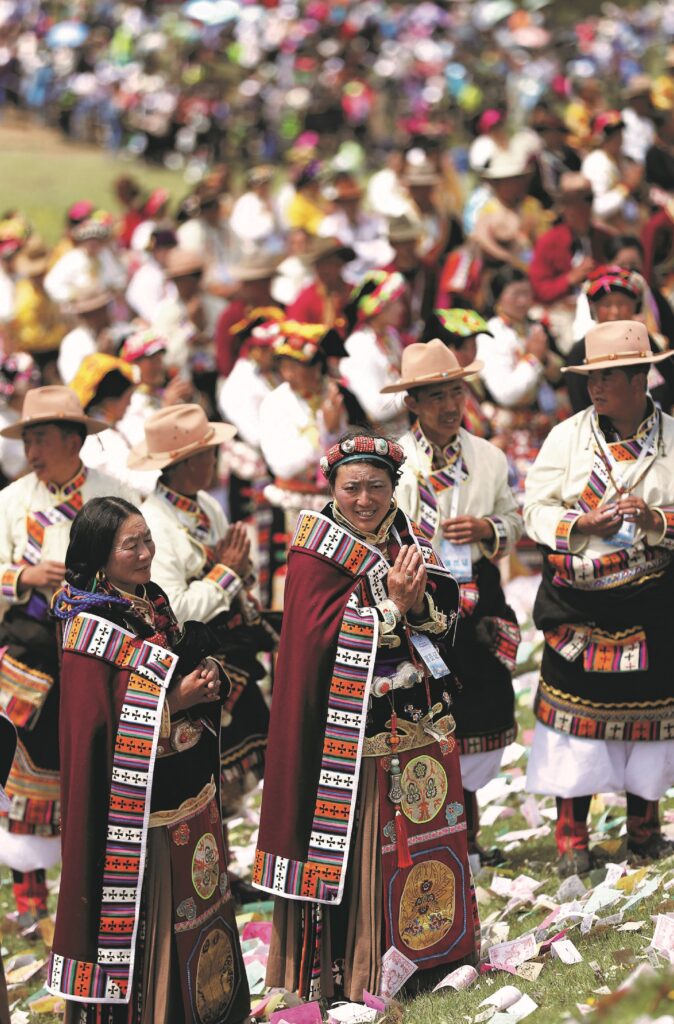
藏族是青藏高原的原住民,在中国境内主要分布于西藏自治区、青海省、四川省西部及云南迪庆、甘肃甘南等地。一千多年来,藏族人民创造了灿烂的民族文化,在医学、建筑、文学、音乐、舞蹈、绘画、雕塑等方面均有丰富的遗产和成就。因地处高寒,藏族服饰多以毛毡、羊绒等为原材料,其服饰的基本特征是长袖、宽腰、长裙、长靴等,并以金玉珠宝作为配饰。(新华社记者 江宏景 摄)
In China, Tibetans, the indigenous people of the Qinghai-Tibet Plateau, inhabit mainly the Tibet Autonomous Region, Qinghai Province, the west of Sichuan Province, Diqing in Yunnan Province, and Gannan in Gansu Province. Over the past one thousand years, the Tibetan people have created a splendid ethnic culture, with rich heritage and achievements in medicine, architecture, literature, music, dance, painting, and sculpture. Because of the cold weather and high altitude of where they live, Tibetans wear mostly felt and cashmere. The basic characteristics of their clothes are long sleeves, wide waist line, long dress and long boots, with gold or jade jewelry as accessories. (Photo by Jiang Hongjing, journalist of Xinhua News Agency)
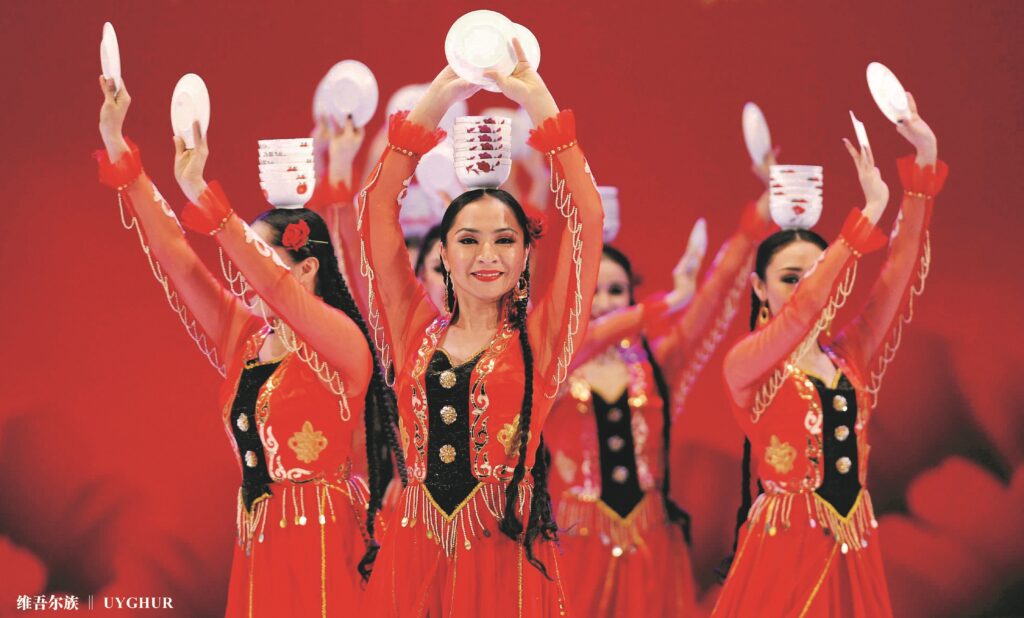
维吾尔族在中国主要聚居在新疆维吾尔自治区,在漫长的历史发展过程中,维吾尔族人民形成独特的民族习俗,擅长歌舞表演、手工艺术等技艺。传统着装上,男子身着“袷袢”外衣中间系带;女子一般穿连衣裙,外罩坎肩或上衣。(新华社记者 沙达提 摄)
Uyghurs in China live mainly in Xinjiang Uyghur Autonomous Region. In the long process of historical development, the Uyghur people have formed unique ethnic costumes. They are good at singing and dancing, handicrafts and other skills. In terms of traditional costumes, Uyghur men are dressed in chapan (overcoats) with belts around the waist. Women usually wear dresses with jackets or blouses. (Photo by Shadati, jounalist of Xinhua News Agency)
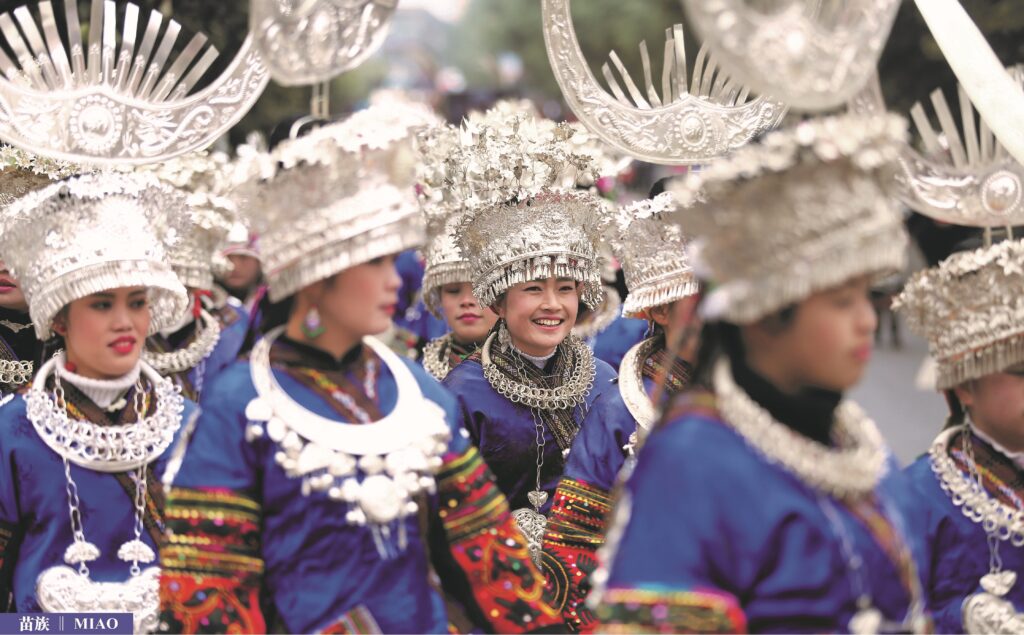
苗族在中国主要分布于贵州、湖南、广西、云南、四川等省区。其先民最早居住于黄河中下游,后因战乱等原因迁入西南山区及云贵高原等地。苗族的传统信仰为自然崇拜和祖先蚩尤,形成独有而神秘的部落文化,尤其体现在宗教仪式、服饰文化等方面。其服饰式样繁多,色彩艳丽,以银饰见长,其传统“盛装”仅插在发上的头饰就有几十种。(新华社记者 陶亮 摄)
The Miao people inhabit mainly Guizhou, Hunan, Guangxi, Yunnan, Sichuan, and other provinces and regions in China. Its ancestors first lived in the middle and lower reaches of the Yellow River, and later, due to war and other reasons, moved to the mountainous areas in the southwest as well as the Yunnan-Guizhou Plateau. In terms of traditional beliefs, the Miao people worship both Nature and Chiyou, one of the ancestors in the Chinese mythology. These beliefs form a unique and mysterious tribal culture that manifests in particular in religious rituals and ethnic costumes. Their clothes are of varied styles and gorgeous colors. The Miao people are known for their silver jewelry. They have dozens of types of hair accessories just to decorate the bun on the head when they dress up in traditional costume. (Photo by Tao Liang, journalist of Xinhua News Agency)
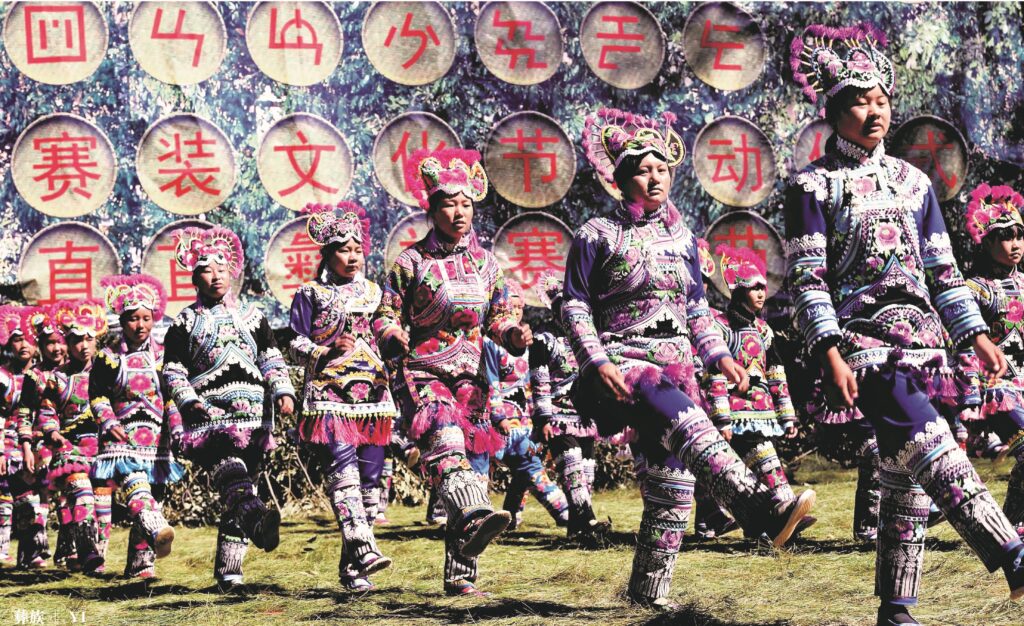
彝族主要分布于云南、四川、贵州、广西四省的高原与沿海丘陵之间,凉山彝族自治州是全国最大的彝族聚居区。彝族传统信仰为自然神灵、图腾、祖先崇拜,深受万物有灵的观念影响。由于彝族支系繁多,因而服饰种类多姿,但都以大量银制品及刺绣进行装饰。(新华社记者 杨宗友 摄)
The Yi people inhabit mainly between the plateaus and coastal hills of Yunnan, Sichuan, Guizhou, and Guangxi Province. Liangshan Yi Autonomous Prefecture is their largest community in China. Their traditional beliefs, which are deeply influenced by the concept of animism, include the worship of natural gods, totems, and ancestors. Since this ethnic group has multiple branches, it turns out that there are many types of Yi costume, all of which are heavily decorated with silver ornaments and embroideries. (Photo by Yang Zongyou, journalist of Xinhua News Agency)
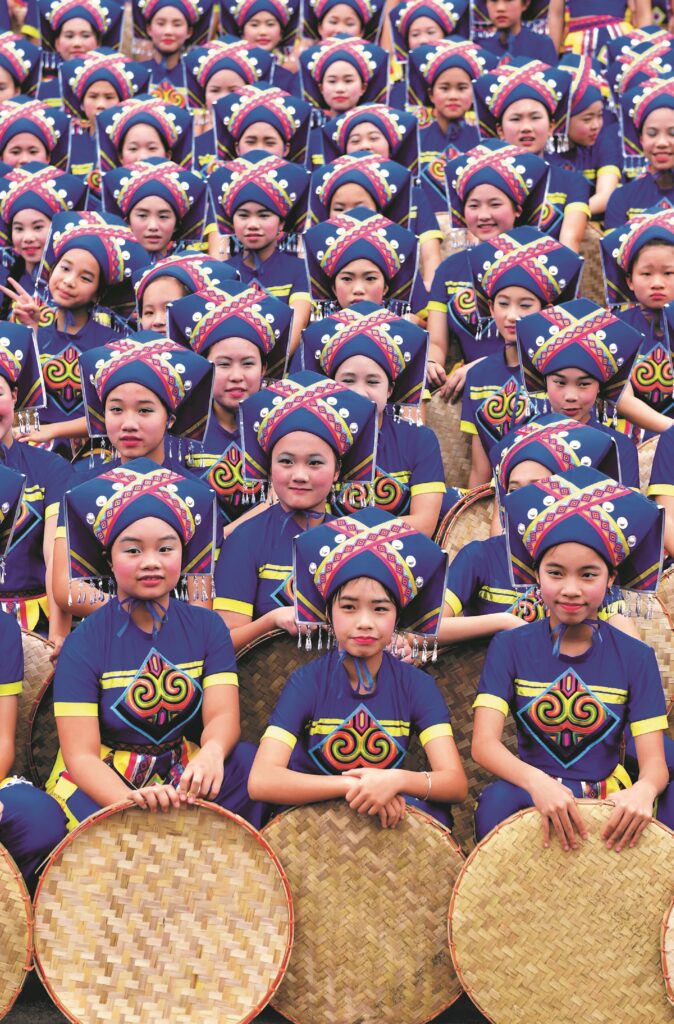
壮族是我国少数民族中人口最多的一个民族,主要聚居于南方,广西壮族自治区是其主要分布区。壮族的文化艺术丰富多彩、历史悠久,传统民间信仰为多神宗教。壮族妇女擅长纺织和刺绣,所织的壮布和壮锦,以图案精美和色彩艳丽著称。(新华社记者 黄孝邦 摄)
Zhuang is the most populous ethnic minority in China. They live mainly in the south and Guangxi Zhuang Autonomous Region is their main compact community. Zhuang’s culture and art are rich, diverse, and of a long history. Their traditional folk belief is polytheistic. Zhuang women are good at weaving and embroidery. The Zhuang cloth and Zhuang brocade are known for their exquisite patterns and bright colors. (Photo by Huang Xiaobang, journalist of Xinhua News Agency)
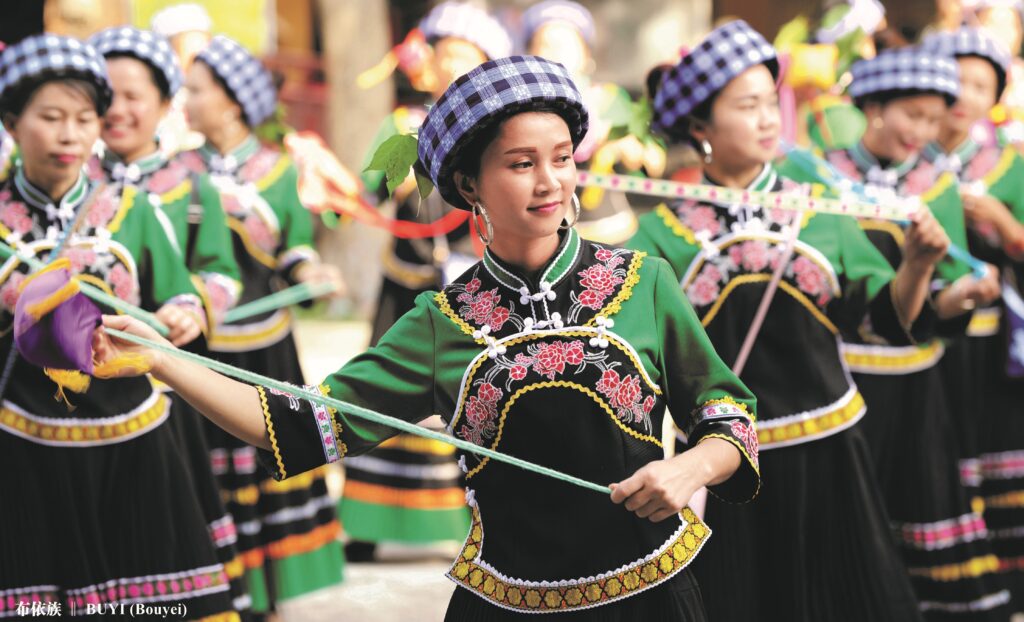
布依族主要分布在贵州、云南、四川等省,是中国西南部一个较大的少数民族,该民族传统信仰为祖先和多种神灵。布依族的文化艺术丰富多彩,民间工艺素负盛名,包括纺织、蜡染、刺绣、竹编、雕刻等。布依族服饰多为青、蓝、白等色,自制的织锦和蜡染是布依族服饰的主要特点。(新华社发 杨文斌 摄)
Inhabiting mainly Guizhou, Yunnan, and Sichuan Province, Bouyei is a large minority group in southwest China. They have traditional beliefs of ancestors and various gods. Their culture and art are rich and diverse, and their handicrafts, such as textile, batik, embroidery, bamboo weaving, and sculpture, enjoy a high reputation. Bouyei costumes are mostly turquoise, blue, and white, featuring homemade brocade and batik. (Photo by Yang Wenbin, Xinhua News Agency)
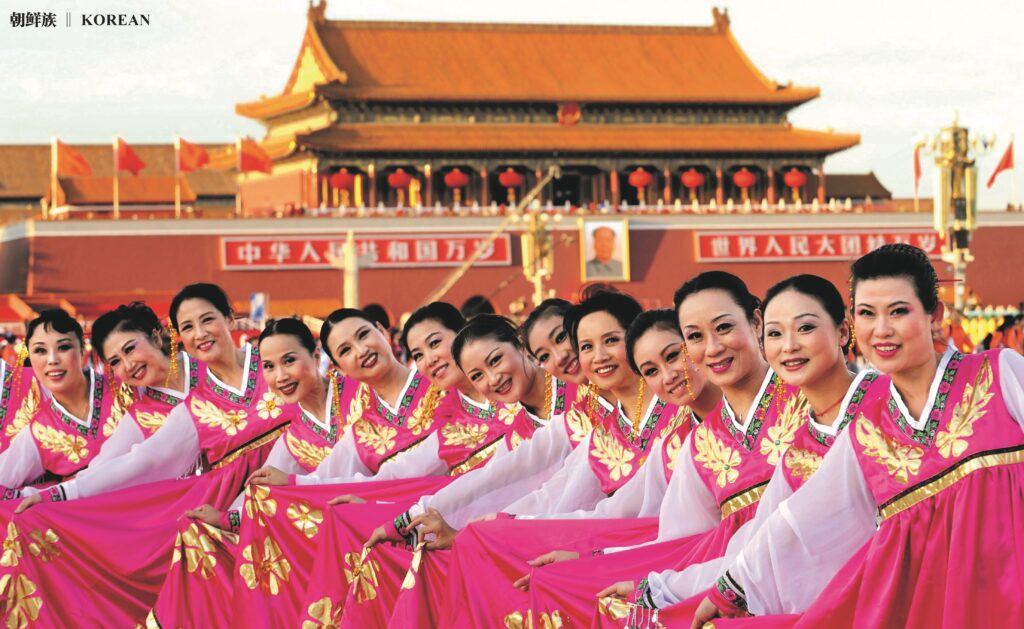
中国境内的朝鲜族主要分布在吉林、黑龙江、辽宁东北三省。在长期的历史发展过程中,朝鲜族创造出适合自身生存的诸多生活风俗文化。朝鲜族服饰色彩素雅或明快,白色最受崇尚,所以朝鲜族又被称为“白衣民族”。朝鲜族女人一般着短衣长裙,男人着短衣宽腿裤,此外男装还有长袍作为礼服之用。(新华社记者 王颂 摄)
The Korean ethnic group in China inhabit the three northeastern provinces: Jilin, Heilongjiang and Liaoning. In the long course of history, the Korean people have created life styles, customs, and cultures that suit their own survival. The colors of Korean costumes are either simple and elegant or bright and lively. Koreans are called “white-dress ethnic group” for their preference of the color white. Korean women usually wear short tops and long dresses, and men are dressed in short tops and loose pants. Men also wear robes as a ceremonial attire. (Photo by Wang Song, journalist of Xinhua News Agency)
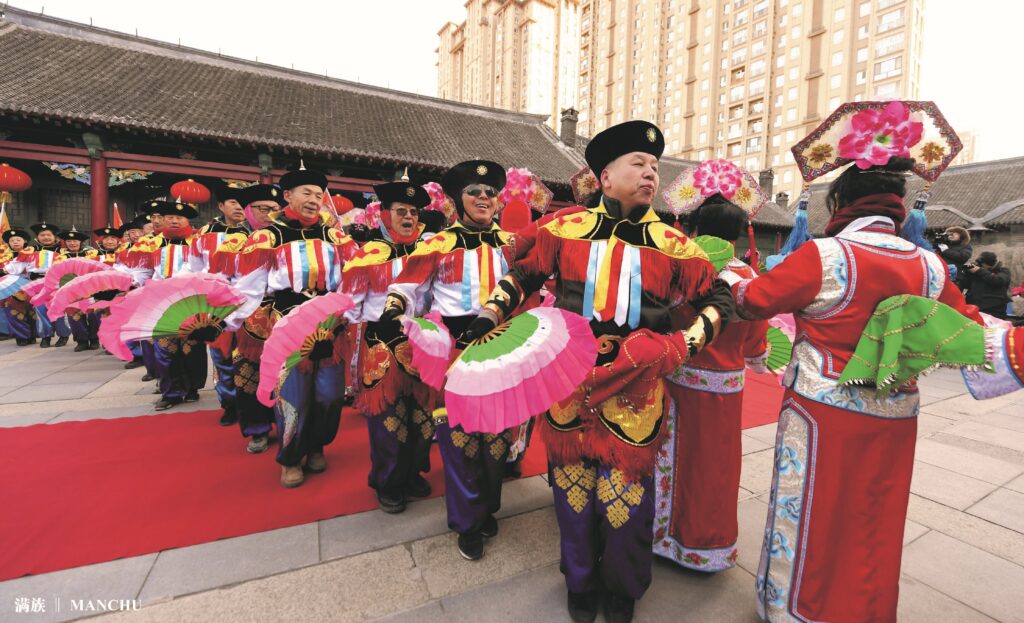
满族人口在少数民族中位列第二,分布于全国各地,以辽宁、河北、黑龙江、吉林和内蒙古自治区、北京等地为多,是一个善于博收外来文化并融汇创新的民族。满族男子的袍褂两侧开叉,腰中束带便于骑射,女子穿宽大的直筒旗袍。入关以后,满汉服装逐渐趋于一致,女子旗袍历经演变,现已成为中国传统女装的代表。(新华社记者 张楠 摄)
Manchu people rank the second in population among the ethnic minorities and live all over the country mainly in Liaoning, Hebei, Heilongjiang, Jilin, Inner Mongolia Autonomous Region and Beijing. They are renowned for staying open to foreign cultures, being able to integrate different cultures and enrich their own. Manchu men wear robes slit at both sides, with belts around the waist to make it easy for riding and shooting. Women wear loose, straight cheongsams. After Manchu people entered the hinterland, Manchu and Han costumes have gradually assimilated and women’s cheongsam has evolved into a symbol of the traditional costume for Chinese women. (Photo by Zhang Nan, journalist of Xinhua News Agency)
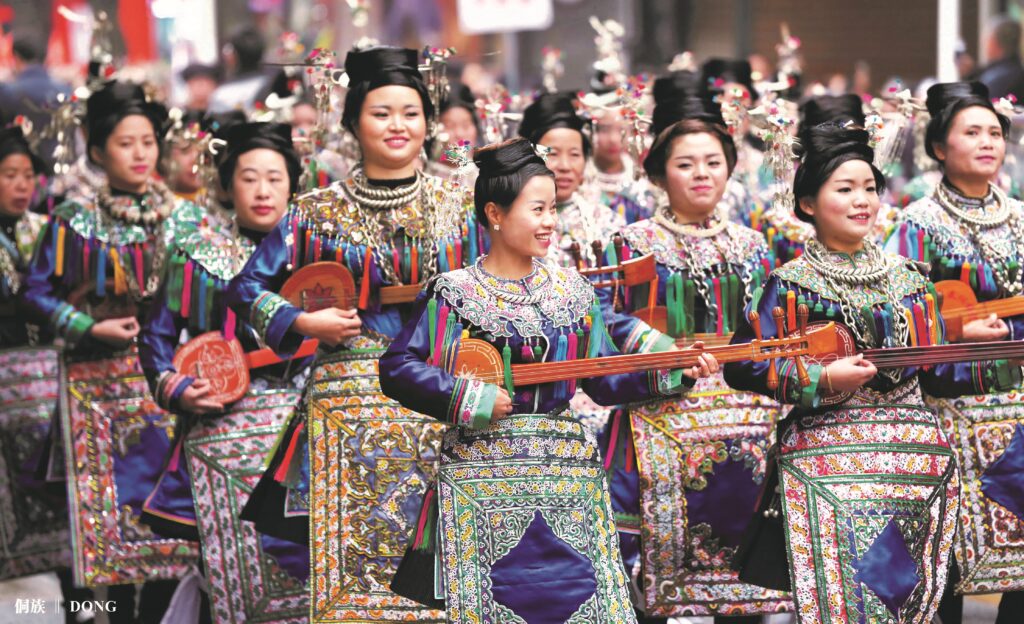
侗族主要分布于贵州、湖南、广西、湖北等地区,侗族人民自古在依山傍水之地建村立寨,男耕女织,传统信仰为多神教,一些古老的祭祀仪式和生活习惯依旧在传承。侗族服饰风格多样,银饰为主要装饰品。(新华社发 吴吉斌 摄)
The Dong people live mainly in Guizhou, Hunan, Guangxi, and Hubei. Since ancient times, they have built villages near mountains and rivers, where men cultivate and women weave. Their traditional belief is polytheistic. Some ancient rituals and lifestyles are well inherited and are still in practice. The Dong costume is diverse in style, with silver ornaments as their main decoration. (Photo by Wu Jibin, Xinhua News Agency)
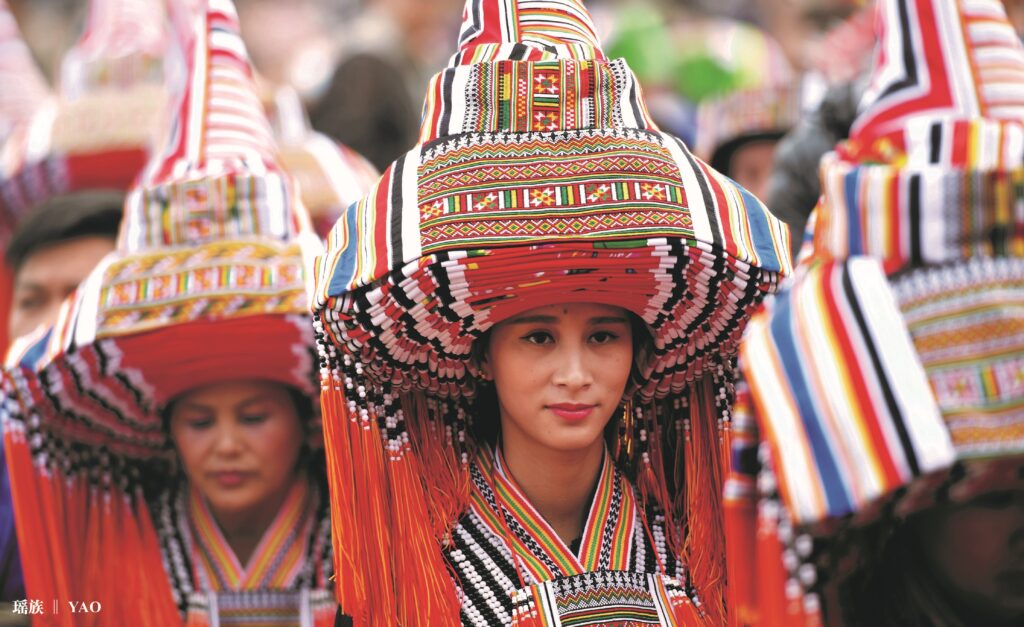
中国的瑶族主要分布在南方的广西、湖南、广东、云南、贵州和江西等省区山地,其中以广西为最多,谓“南岭无山不有瑶”。因瑶族起源传说、生产方式、居住和服饰等方面的特点,有“红瑶”、“盘瑶”、“过山瑶”、“茶山瑶”、 “红头瑶”等30余个分支。瑶族服饰大多华丽,尤其是女性服饰,以剌绣装饰、百褶裙为主。(新华社记者 张爱林 摄)
The Yao people inhabit mainly the mountainous areas of Guangxi, Hunan, Guangdong, Yunnan, Guizhou and Jiangxi Province in south China. Since most of them live in Guangxi, people say ‘there is not a single mountain in the south that doesn’t house a Yao”. Due to the characteristics of Yao’s legend of origin, production mode, as well as way of living and clothing, there are more than 30 branches of this ethnic group: Hong Yao, Pan Yao, Guoshan Yao, Chashan Yao, Hongtou Yao, etc. In general, the Yao costume is gorgeous and splendid, especially the women’s clothing, which are mostly pleated skirts decorated with embroideries. (Photo by Zhang Ailin, journalist of Xinhua News Agency)
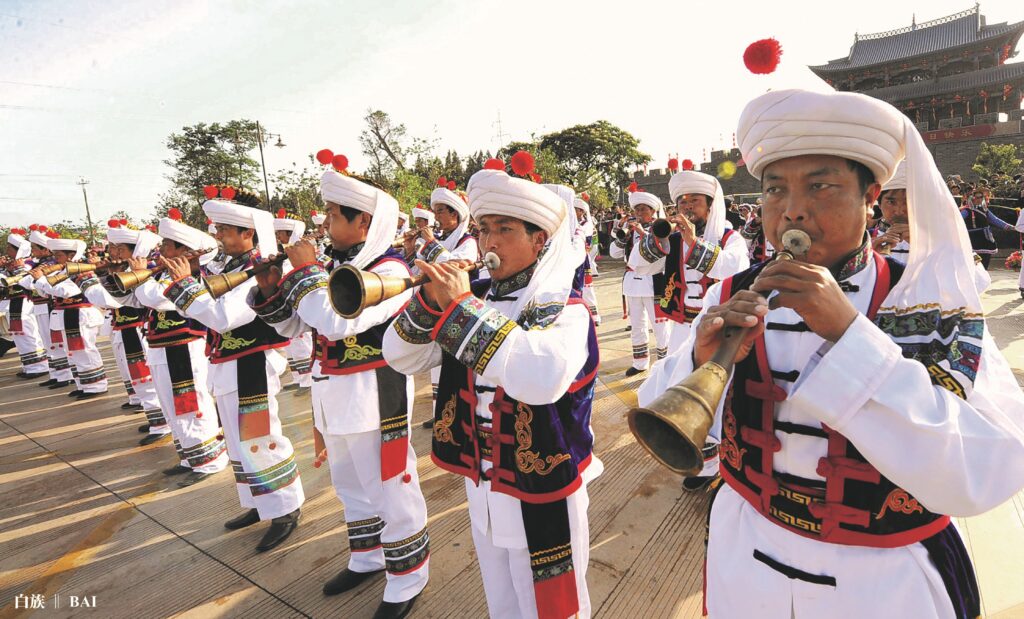
白族主要分布在云南、贵州、湖南等省,其中以云南省的白族人口最多,主要聚居在云南省大理白族自治州。白族崇尚白色,以白色衣服为尊贵。白族传统信奉的宗教为本主崇拜,本主白语叫“武增”,是白族村社的保护神。白族节庆活动丰富,如三月街、本主节、蝴蝶会、剑川骡马会等,都非常具有地域及民族特色。(新华社记者 杨宗友 摄)
The Bai people live mainly in Yunnan, Guizhou, and Hunan, among which Yunnan has the largest Bai population. Dali Bai Autonomous Prefecture is their main compact community. The Bai people advocate white and consider white clothes as a sign of nobility. The traditional religion of Bai is the worship of its own master Benzhu, who is called Wuzeng in the Bai language and is the guardian of Bai villages. The Bai people have many festival activities, such as March Street, Benzhu Festival, Butterfly Fair, and Jianchuan’s Horse and Mule Fair, all of which have regional and ethnic characteristics. (Photo by Yang Zongyou, journalist of Xinhua News Agency)
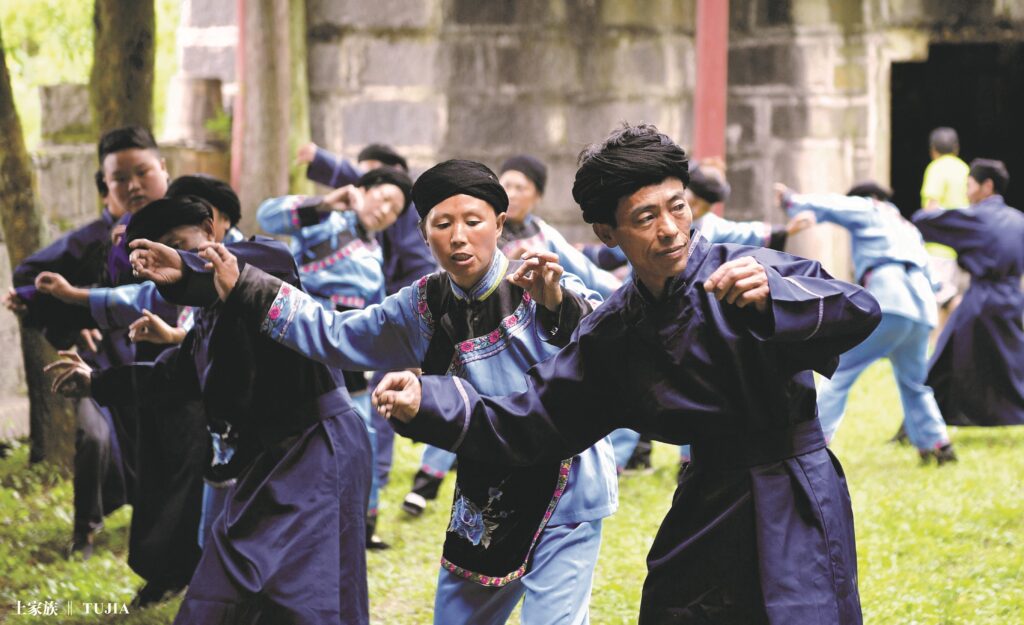
土家族自称“毕兹卡”、“密基卡”或“贝锦卡”,意为“土生土长的人”,主要分布在中国湖南、湖北、四川、贵州交界地带的武陵山区。土家族传统信仰多神宗教,注重祭祀活动。其服饰素朴,土家妇女善纺细布,自织自纺青蓝色土布或麻布做服装。此外土家人还擅长染织、编织、刺绣、雕刻、绘画、剪纸等民间工艺。(新华社发)
The Tujia people call themselves bizika, mijika or beijinka, meaning “native people”. They live mainly in the mountainous area of Wuling where Hunan, Hubei, Sichuan, and Guizhou provinces meet. The Tujia people believe in polytheistic religion and attach great importance to sacrificial ceremonies. Their clothes are simple and plain. Tujia women are good at spinning muslin and using their homespun blue cloth or linen to make clothes. The Tujia people are also good at dyeing, weaving, embroidery, carving, painting, paper cutting, and other folk crafts. (Xinhua News Agency)
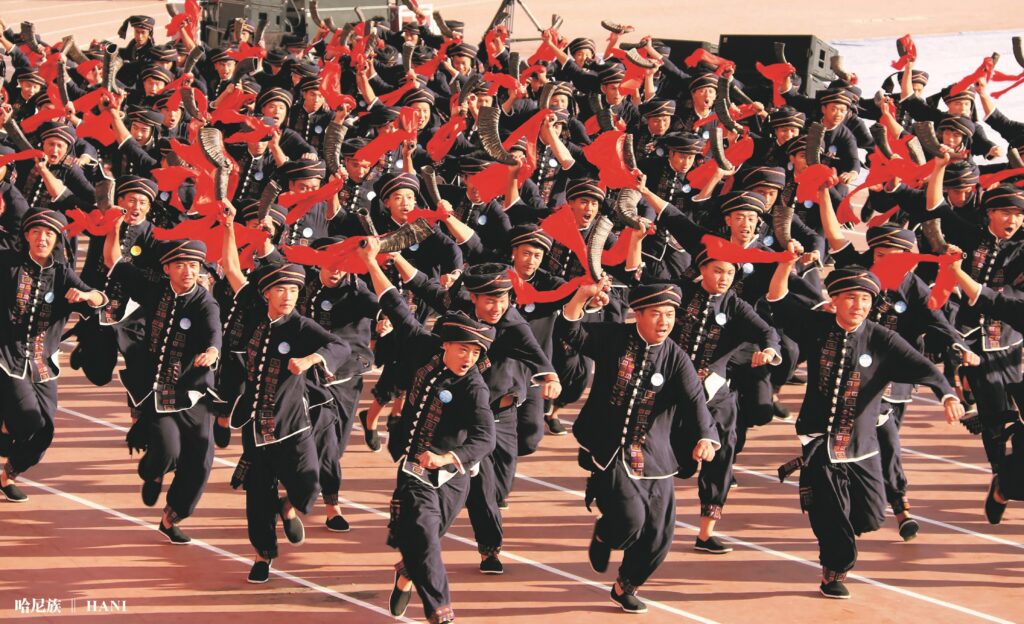
哈尼族绝大部分集中分布于云南南部元江、澜沧江两江的中间地带,利用山区自然条件开垦梯田,是哈尼族的特长和千年传统,造就了赫赫有名的哈尼梯田景观。梯田凝结着哈尼族悠久漫长的历史,沉淀着丰厚广博的文化。哈尼族的服装一般用自己染织的土布做成,以蓝色和黑色为主,哈尼族男子一般着对襟上衣、宽松长裤、黑布包头,女子服装款式和装饰样式繁复。(新华社记者 字强 摄)
Most of the Hani people live in the middle of Yuanjiang River and Lancang River in southern Yunnan. It is their specialty and longtime tradition to take advantage of the natural conditions in the mountainous areas to cultivate terraced fields. Thus the famous landscape of Hani terraced fields was created. Embedded in the terraced fields is the long history and rich, extensive culture of the Hani people. Their clothes are usually made of blue and black cloth, dyed and woven by themselves. Hani men usually wear duijin coat with the left side of the front closure jointing but not overlapping with the right side, loose trousers, and turbans made of black cloth. Women’s clothes boast sophisticated styles and decorations. (Photo by Zi Qiang, journalist of Xinhua News Agency)
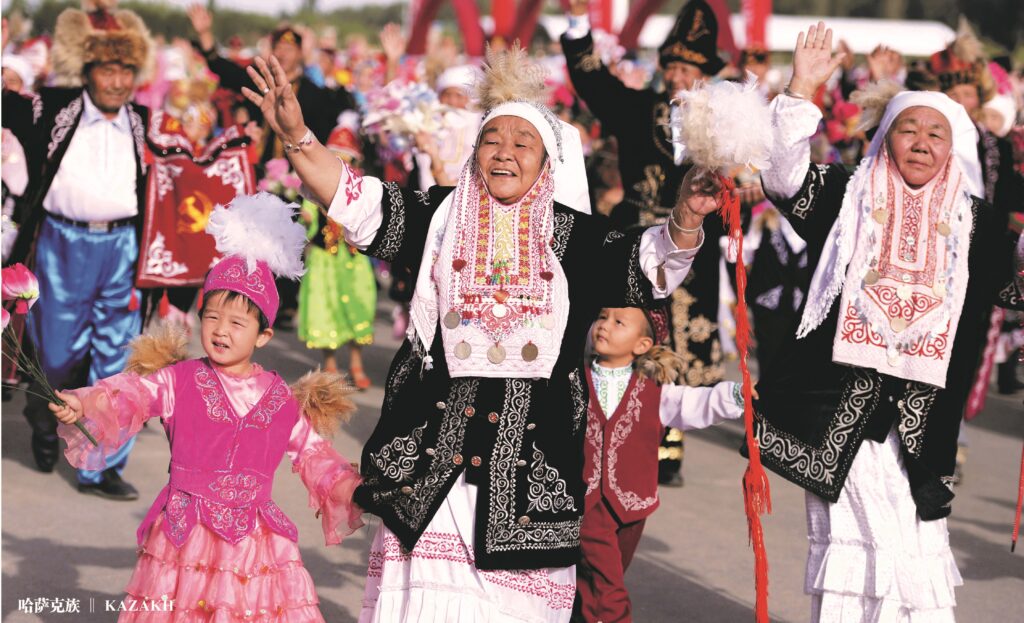
中国的哈萨克族主要分布在新疆维吾尔自治区,该民族的传统信仰有萨满教、伊斯兰教。哈萨克族服饰风格独特,“吐马克”是哈萨克族男子冬季戴的帽子,具有遮风雪、避寒气的功能;妇女的头饰有帽子和头巾,女孩子从小戴“塔克亚”帽子,顶上插有表示吉祥的猫头鹰羽毛,缀有光彩夺目的珠玉。(新华社记者 李明放 摄)
The Kazakh people in China live mainly in the Xinjiang Uyghur Autonomous Region. Their traditional beliefs include Shamanism and Islam. The Kazakh costume has a unique style. Tumake, a hat worn by Kazakh men in winter, can protect against wind, snow and cold. Women wear hats and headscarves, and girls grow up wearing Takeya – hat topped with auspicious owl feathers and glittering pearls. (Photo by Li Mingfang, journalist of Xinhua News Agency)
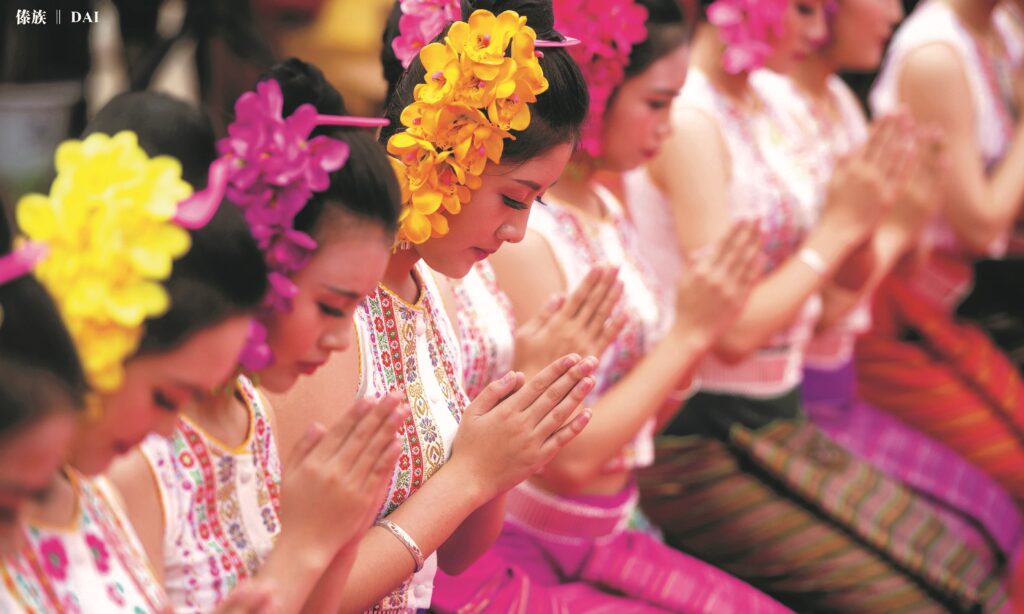
中国傣族主要聚居在云南省,傣族人民依水而居,喜水,被称为“水的民族”。傣族视孔雀、大象为吉祥物。民间故事丰富多彩,舞蹈种类繁多,医学也很发达。傣族传统信仰有原始宗教和佛教。傣族服饰独特,妇女传统着窄袖短衣和筒裙,男子着无领对襟或大襟小袖短衫,多用白布或青布包头。(新华社记者 胡超 摄)
The Dai people in China mainly live in Yunnan Province. They live by water and are fond of water. Thus the are called “the ethnic group of water”. They regard peacocks and elephants as mascots and boast rich folk stories, various dances, and advanced medical science. Dai’s traditional beliefs include primitive religions and Buddhism. Dai costume is unique. Traditionally, women wear short tops with narrow sleeves and tube skirts. Men wear collarless tops with buttons down the front or short shirts with large fronts and small sleeves, and use white or turquoise cloth to wrap the head. (Photo by Hu Chao, journalist of Xinhua News Agency)
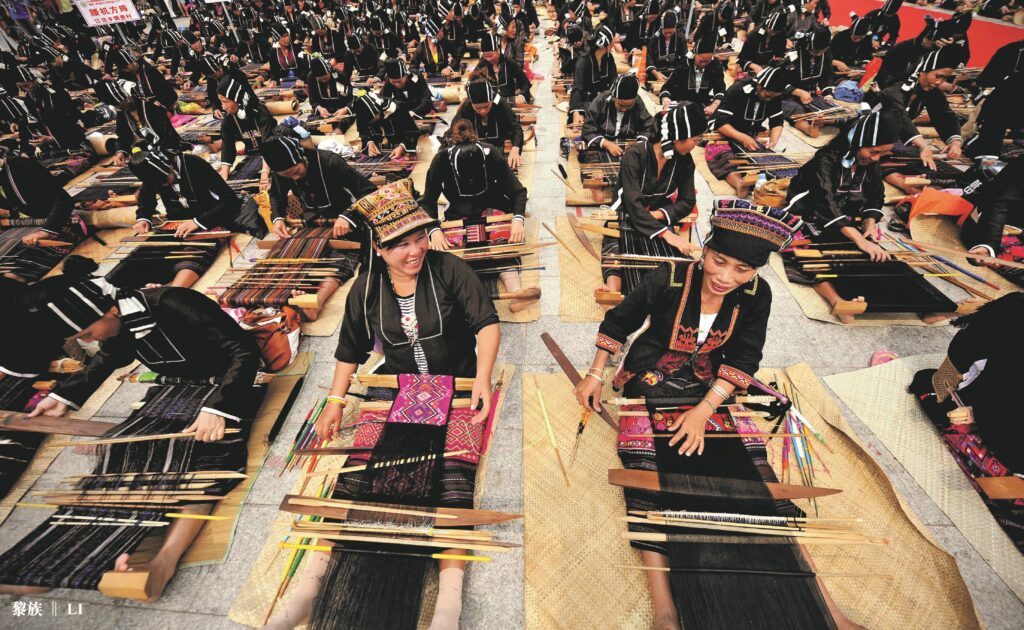
黎族主要聚居在海南省,是海南岛最早的居民。黎族妇女的纺织早已闻名于世,尤对木棉的纺织独具匠心。黎族传统服饰文化内涵丰富,在传统服饰中,黎族女子常穿直领、无领、无对襟上衣,下穿长短不同的筒裙。男子上衣无领、对胸开襟,下着腰布。(新华社记者 郭程 摄)
The Li people mainly live in Hainan Province and are the earliest residents of Hainan Island. Li women’s textile, especially the unique and original kapok textile, has long been famous in the world. The costumes of Li have a rich cultural connotation. Traditionally, Li women often wear duijin jackets, with the left side of the front closure jointing but not overlapping with the right side, with straight collar, no collar or no button, and tube skirts of different length. Men wear collarless top with front opening, with a loincloth underneath. (Photo by Guo Cheng, journalist of Xinhua News Agency)
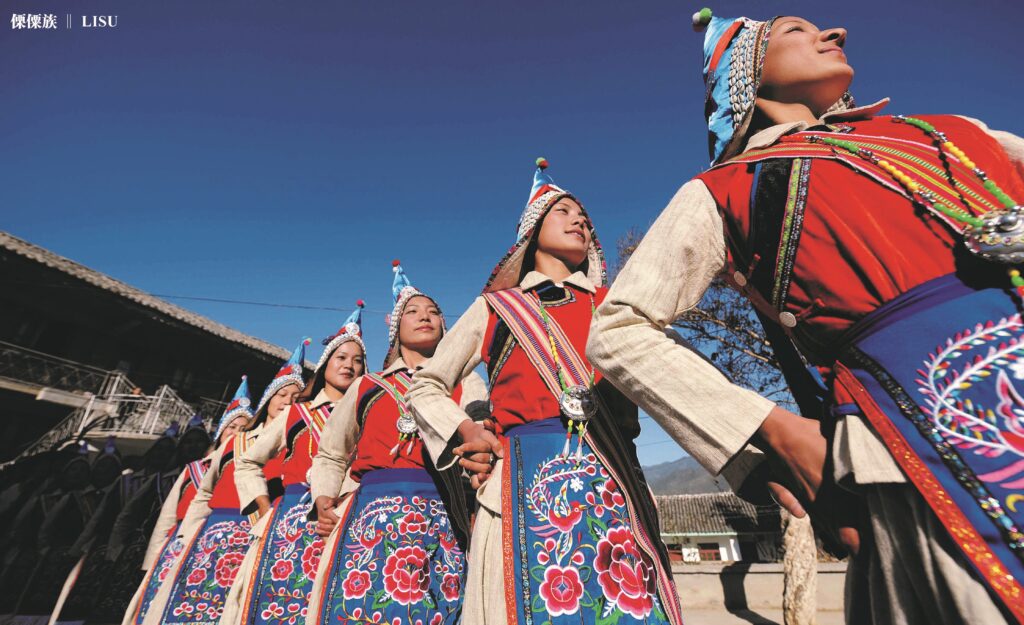
傈僳族源于古老的氐羌族系,与彝族有着渊源关系,在中国主要分布在云南省和四川省,其传统信仰为原始宗教,崇拜自然与灵魂。傈僳族的传统服饰主要为麻布制作的衣服,各地服饰颜色有所差异,主要分黑、白、花傈僳3种。傈僳族人民的主要艺术活动为唱民歌、跳舞,常用乐器为琵琶、口弦。(新华社记者 蔺以光 摄)
Lisu has its origin from the ancient tribes of Di and Qiang and is closely related to the Yi ethnic group. The Lisu people live mainly in Yunnan and Sichuan Province. Their traditional belief is a primitive religion that worships Nature and soul. Lisu’s traditional clothes are mainly made of linen. They vary in color and can be divided into three categories: black, white,and colorful Lisu. The artistic activities of the Lisu people mainly include singing folk songs and dancing. The most commonly used musical instruments are pipa (Chinese lute) and kouxian (jaw harp). (Photo by Lin Yiguang, journalist of Xinhua News Agency)
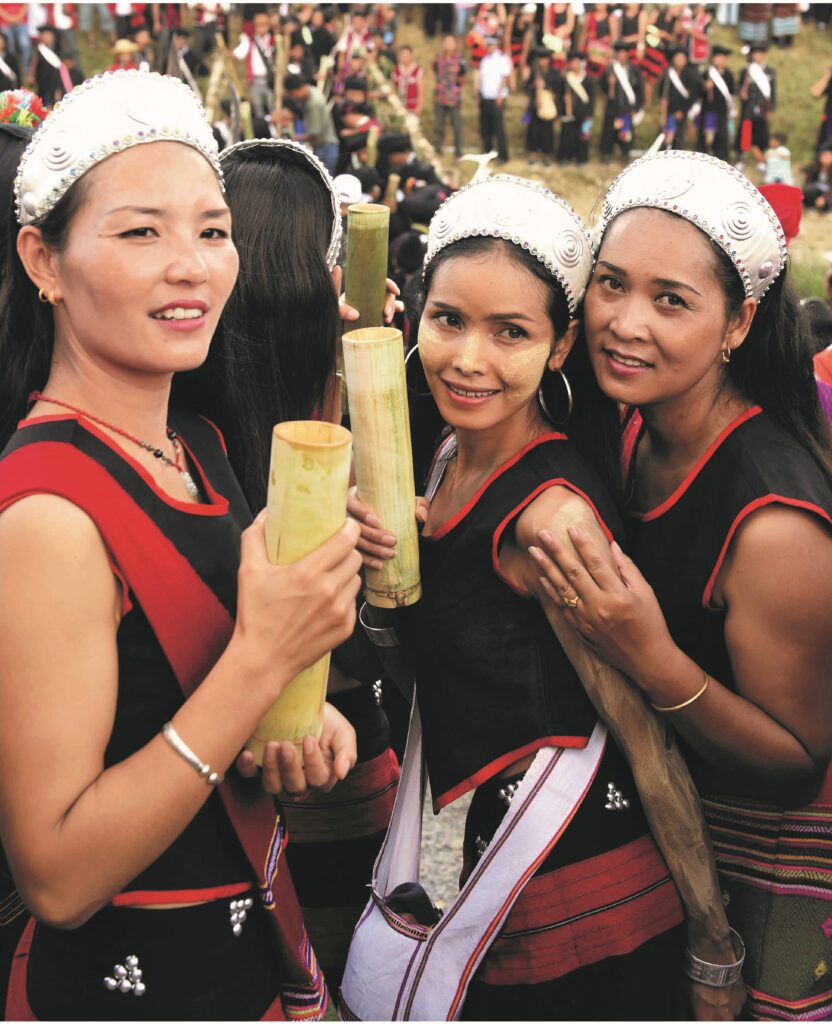
中国的佤族主要居住在云南省西南部,长期以来,佤族与汉族、傣族、拉祜族的相互交流促进了其经济发展。佤族传统宗教信仰有原始宗教、佛教等。传统节日主要有新火节、播种节和新米节,其中新火节是佤族的年节。佤族传统男子服装为无领短上衣,裤子短而肥大;女子穿黑色无领短衣,下围直筒折裙。(新华社记者 杨宗友 摄)
The Wa people mainly live in the southwest Yunnan Province, and their longtime interaction with Han, Dai and Lahu ethnic groups has promoted their economic development. Wa’s traditional religious beliefs include primitive religions and Buddhism. Their traditional festivals include the New Fire Festival, the Sowing Festival and the New Rice Festival. The first one is their New Year Festival. Traditionally, Wa men wear short, collarless tops and short, loose pants. Women wear short, black, collarless tops with folded tube skirts. (Photo by Yang Zongyou, journalist of Xinhua News Agency)
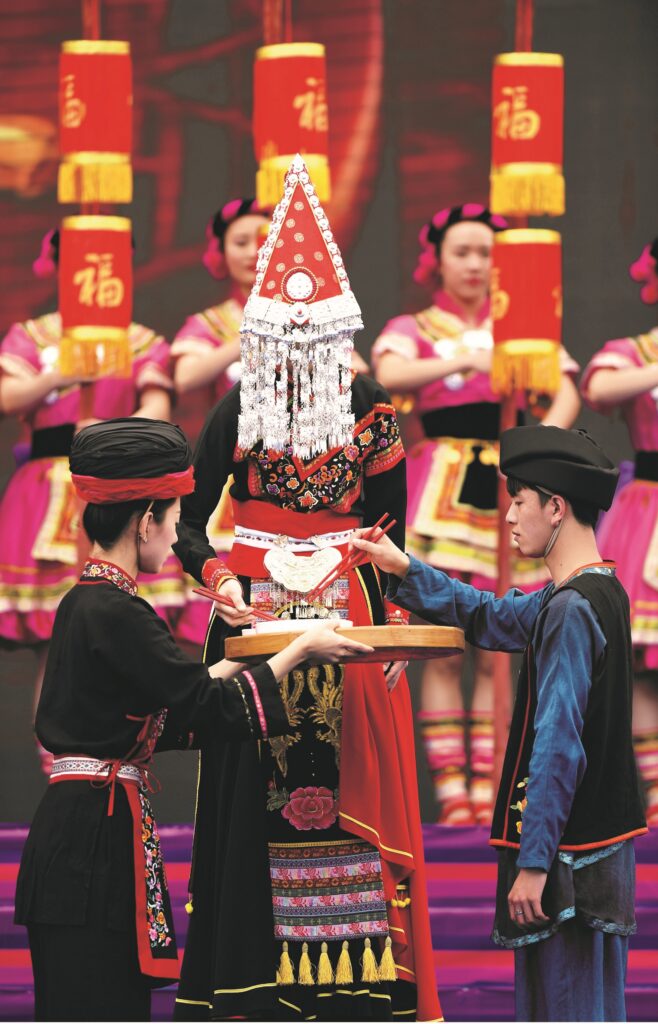
畲族是中国南方的游耕民族,一千多年来大部分畲族从原始居住地广东潮州迁徙至福建、浙江、江西、安徽等省份,拓荒殖土、安居乐业。在迁徙过程中,畲族创造了绚丽多姿的文化艺术,民歌渗透进劳作生活,工艺种类繁多,尤其编织技艺备受赞誉,包括竹编、草编、织绣等。畲族传统服饰崇尚青、蓝色,多着自织的苎麻布。(新华社记者 姜克红 摄)
She is an ethnic group of shift farming in south China. For more than 1000 years, most of the She people migrated from Chaozhou (in Guangdong Province), their original place of residence, to Fujian, Zhejiang, Jiangxi, and Anhui to open up virgin soil and live in peace and contentment. In the process of migration, the She people have created colorful culture and art. Folk songs are a part of their working life, and there are also many types of handicrafts. The weaving skills, such as bamboo weaving, straw weaving and embroidery, are particularly well acclaimed. The traditional She costumes advocate turquoise and blue, and are mostly made of self-woven ramie fabrics. (Photo by Jiang Kehong, journalist of Xinhua News Agency)
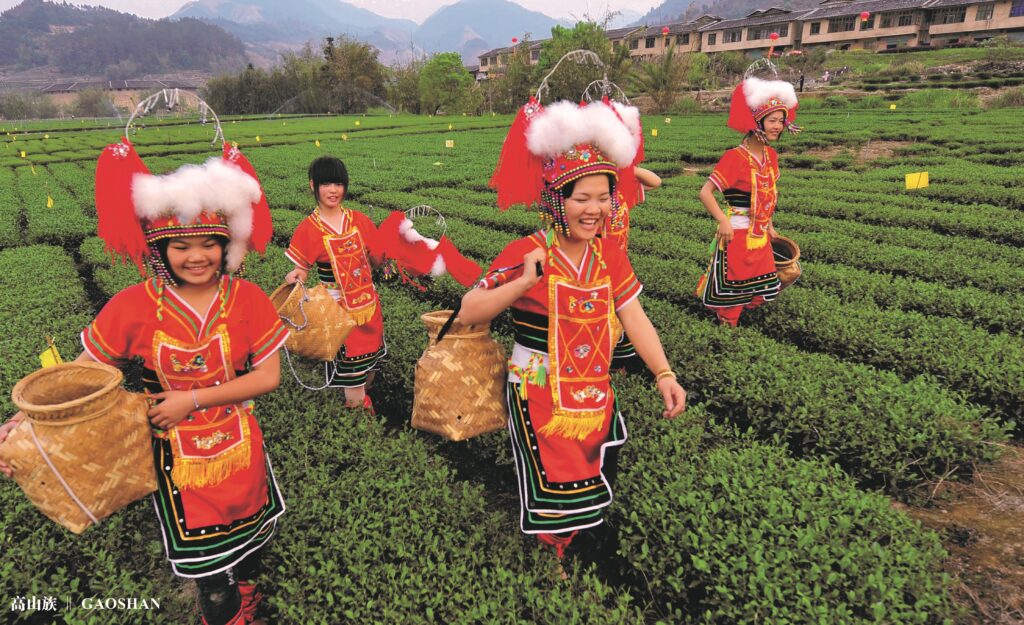
高山族主要居住在中国台湾省,少数散居于福建、浙江等沿海地区。高山族以稻作农耕经济为主,以渔猎生产为辅。高山族的手工工艺主要有纺织、竹编、藤编、刳木、雕刻、削竹和制陶等。高山族的服饰绚丽多彩,高山族女子擅染织各种彩色麻布,喜欢在衣襟、衣袖、头巾上绣精美图案,还喜欢用贝壳、兽骨等磨制成装饰品。(新华社记者 魏培全 摄)
The Gaoshan people mainly live in Taiwan Province of China, with a few scattered in the coastal areas of Fujian and Zhejiang. Their economy is mainly rice-farming, supplemented by fishing and hunting. The handiwork of the Gaoshan people is mainly composed of weaving, bamboo weaving, rattan weaving, wood ripping, carving, bamboo cutting, and pottery making. Their costumes are splendid and colorful. Gaoshan women are good at dyeing and weaving all kinds of colored linens. They like to embroider exquisite patterns on the front, sleeves and headscarves, and they also like to use shells and animal bones to make accessories. (Photo by Wei Peiquan, journalist of Xinhua News Agency)
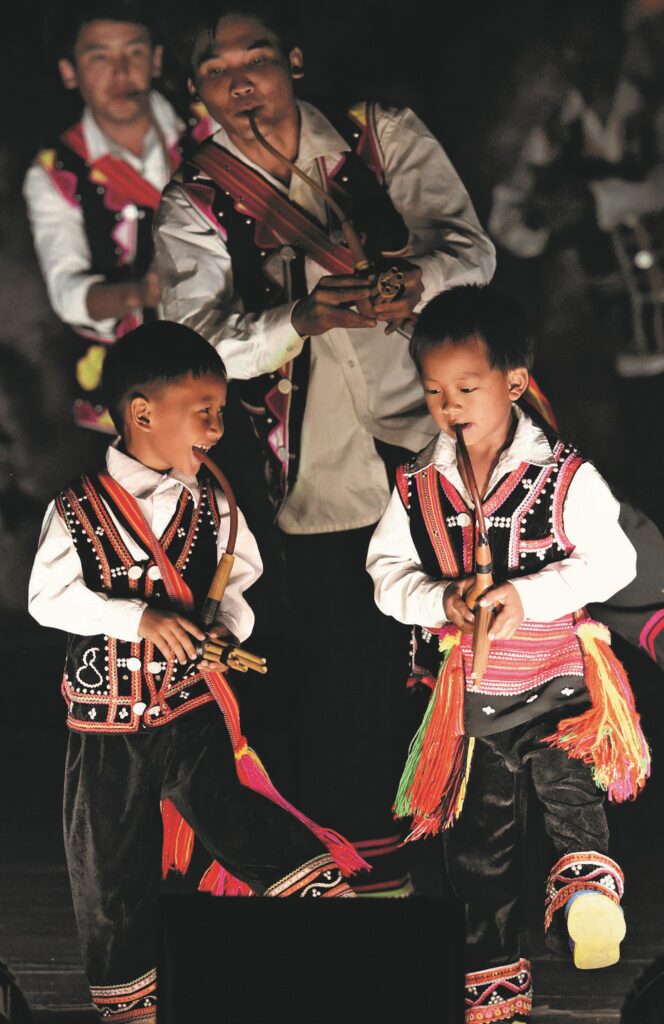
拉祜族是中国最古老的民族之一,主要聚居在云南澜沧江流域的山区,其传统宗教崇拜多神,供奉“厄莎”大神。拉祜族传统服饰兼具早期北方游牧文化和近现代南方农耕文化双重风格的特点,大都以黑布衬底,用彩线和色布缀上各种花边图案,再嵌上洁白的银泡,使整个色彩既深沉而又对比鲜明。(新华社记者 蔺以光 摄)
Lahu, one of the oldest ethnic groups in China, mainly live in the mountains of the Lancang River basin in Yunnan Province, and its traditional religion is polytheistic. They worship the great lord Ersha. Lahu’s traditional clothing features both the early nomadic culture of the north and the modern and contemporary farming culture of the south. The clothes are generally made of black cloth, trimmed with laces and patterns made of colored threads and cloths, and inlaid with white silver bubbles, making the outfit both somber and distinct with contrast. (Photo by Lin Yiguang, journalist of Xinhua News Agency)
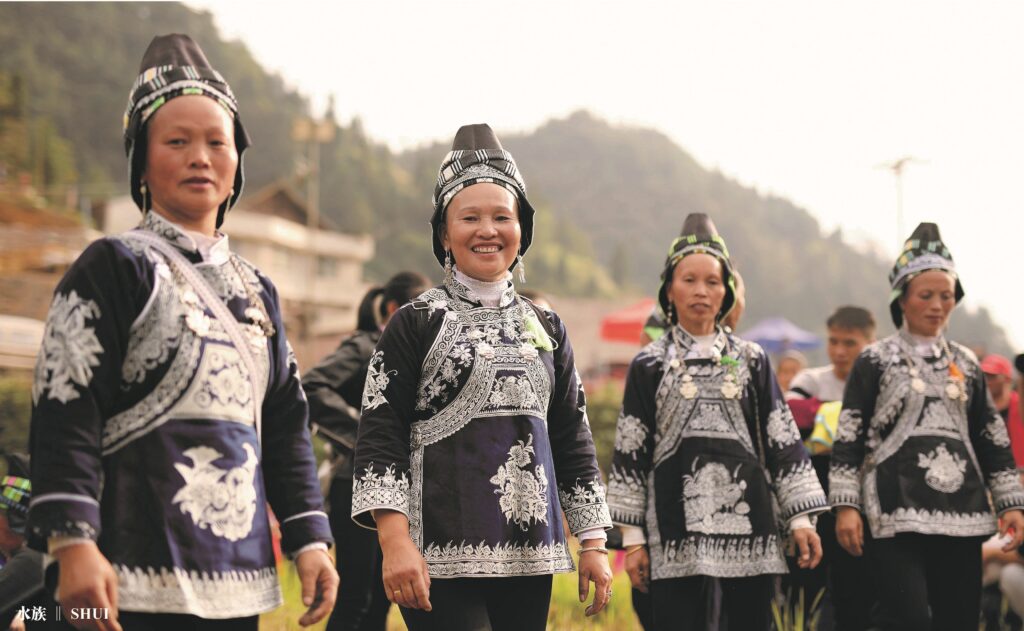
水族主要分布于黔桂交界的龙江、都柳江上游地带。其历史悠久,依旧沿用着水族古文字体系“水书”,保留着图画文字、象形文字、抽象文字兼容的特色。水族的岁时节日丰富而奇特,皆与水族的历史、历法、农耕文化、原始信仰、居住分布等紧密相连。水族人的传统服饰自纺、自织、自染。自制的靛青染色是其服饰的主要特色。(新华社发 黄晓海 摄)
The Shui people inhabit mainly the upper reaches of Longjiang River and Duliu River along the border of Guizhou and Guangxi Province. With a long history, it still follows the ancient writing system of Shui writing, with compatible features of pictographic characters, hieroglyphs and abstract characters. Shui has many unique festivals, all of which closely linked with their history, calendar, farming culture, original beliefs, and habitation. The traditional costumes of the Shui people are self-spun, self-woven and self-dyed. Being dyed with self-made indigo is the main feature of their clothes. (Photo by Huang Xiaohai, Xinhua News Agency)
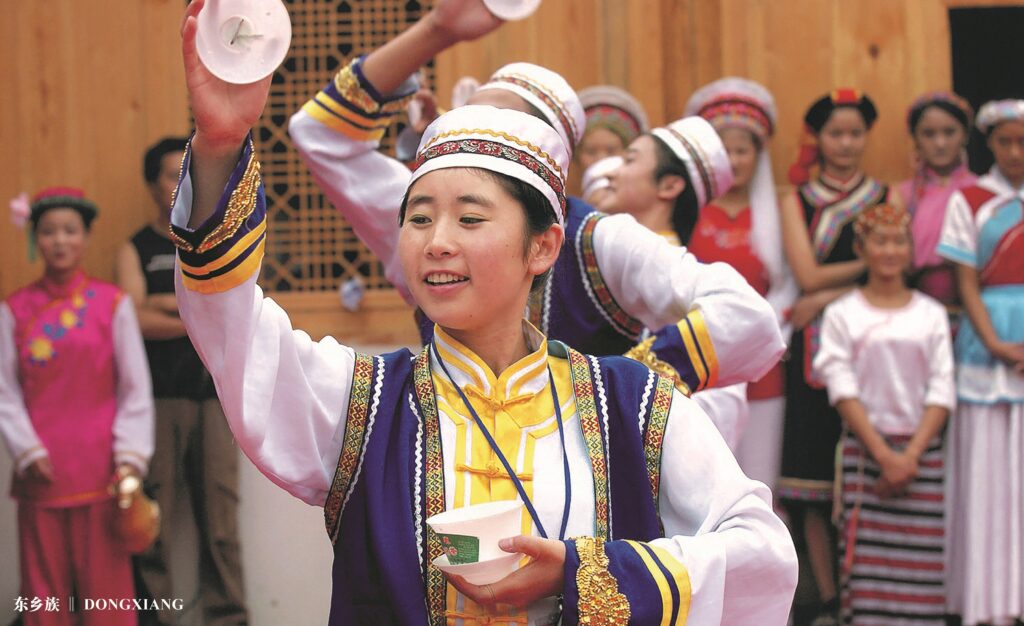
东乡族因主要居住在河州(今甘肃临夏)的东乡而得名,其起源有回回色目人、蒙古人和多民族融合之说,传统信仰为伊斯兰教逊尼派。东乡族人几乎人人会唱会编民歌“花儿”,在过去“花儿”以苦歌和情歌为多,如今更多歌唱新生活。东乡族女子一般都戴盖头,衣着为藏青色或黑蓝色布衣;男子多穿宽大的长袍,束宽腰带,腰带上挂有小刀、荷包等物件。(新华社记者 张旭 摄)
Dongxiang got its name from inhabiting mainly in Dongxiang, Hezhou (now Linxia of Gansu Province), and its origin was said to be the integration of the Huihui Semu, Mongol, and other ethnic groups. Its traditional belief is Sunni Islam. Almost everyone can sing and compose folk songs called Hua’er. In the past, Hua’er used to be mostly bitter songs and love songs. Nowadays, they become tributes of the new life. Dongxiang women generally wear hijabs and navy blue or black-blue dresses made of cloth. Men often wear wide robes, fastened by a wide belt to which they hang small items such as a knife or a pouch. (Photo by Zhang Xu, journalist of Xinhua News Agency)
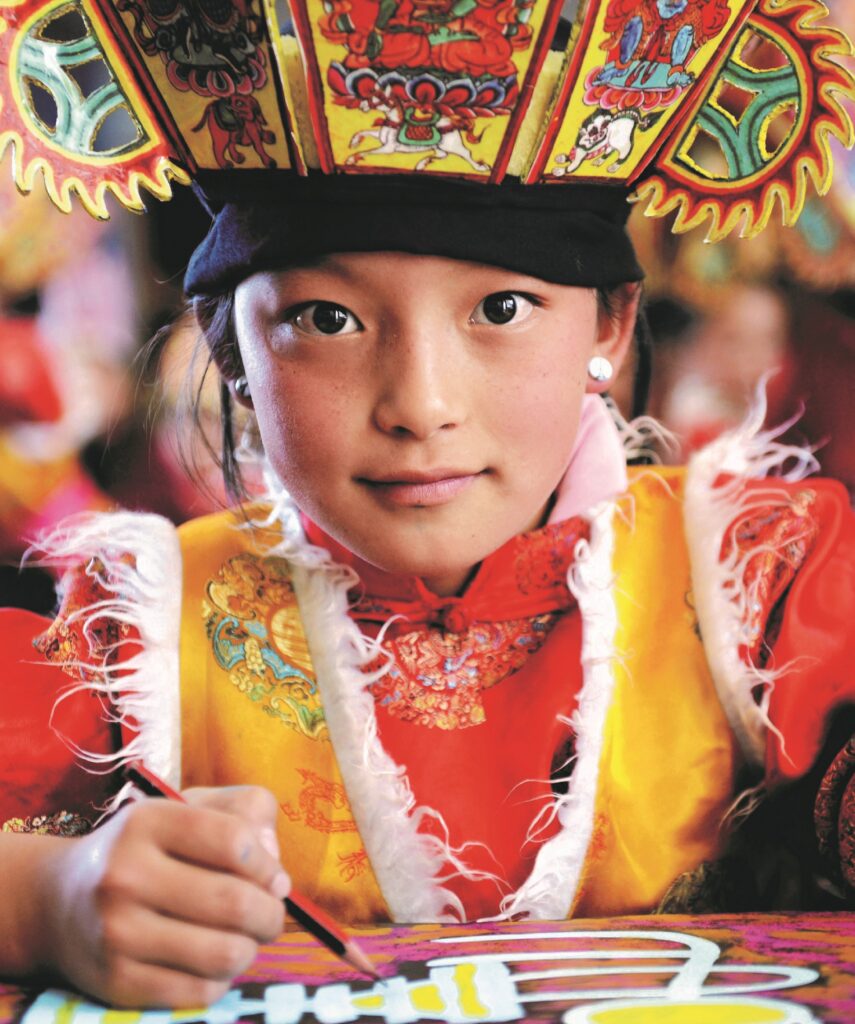
纳西族大部分居住在滇西北的丽江市。纳西族传统信仰为本土宗教东巴教及佛教,东巴教对纳西人的生活产生重要影响,至今延续着各种东巴教祭祀仪式、东巴文、东巴经等文化。纳西族传统服饰“七星披肩”独具特点,它用整块黑羊皮做成,两肩处绣日月图案和依次排列的“七星”,又被称为“披星戴月”,象征着纳西族妇女披星戴月地辛勤劳动。(新华社记者 吴晓凌 摄)
Most Naxi people live in Lijiang City in northwest Yunnan Province. Their traditional beliefs are the native religion of Dongba and Buddhism. The Dongba religion has great influence on the life of the Naxi people, and is preserved in various cultural forms such as rituals of the Dongba religion, Dongba language and Dongba sutra. The traditional Naxi costume seven-star cape has unique characteristics. It is made of a whole piece of black sheepskin, with patterns of the sun, the moon, and the seven stars embroidered on both shoulders. It is also called “wearing the stars and the moon”, a symbol of the hard work of Naxi women. (Photo by Wu Xiaoling, journalist of Xinhua News Agency)
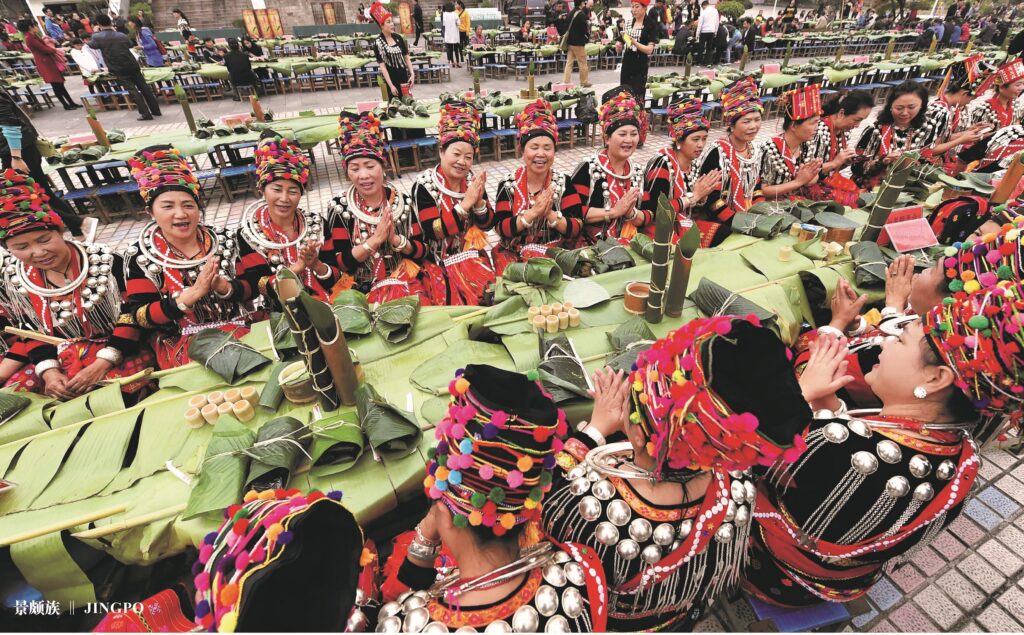
景颇族主要聚居于云南省德宏傣族景颇族自治州,其来源与青藏高原上的古代氐羌人有关,有景颇、载瓦、勒赤、浪峨、波拉5个支系。景颇族服饰风格独特,男子服饰以黑、白为主色,随身背挎筒帕(即背包)和长刀;女子服饰盛装上身装饰银泡、银牌和银穗,下身为各色毛线织出美丽图案的毛质筒裙、红底提花羊毛巾包头。(新华社记者 陈海宁 摄)
The Jingpo people mainly live in Dehong Dai and Jingpo Autonomous Prefecture of Yunnan Province. Their origin can be traced back to the ancient Di and Qiang people on the Qinghai-Tibet Plateau. There are five branches of this ethnic group: Jingpo, Zaiwa, Lechi, Lang’e and Bola. Jingpo has a unique style of clothing. Men are dressed mostly in black and white, carrying a tongpa (i.e. backpack) and a long knife. Women wear tops decorated with silver bubbles, silver plates, and silver tassels, colorful woolen tube skirts with beautiful patterns, and red jacquard scarves made of wool over their head. (Photo by Chen Haining, journalist of Xinhua News Agency)
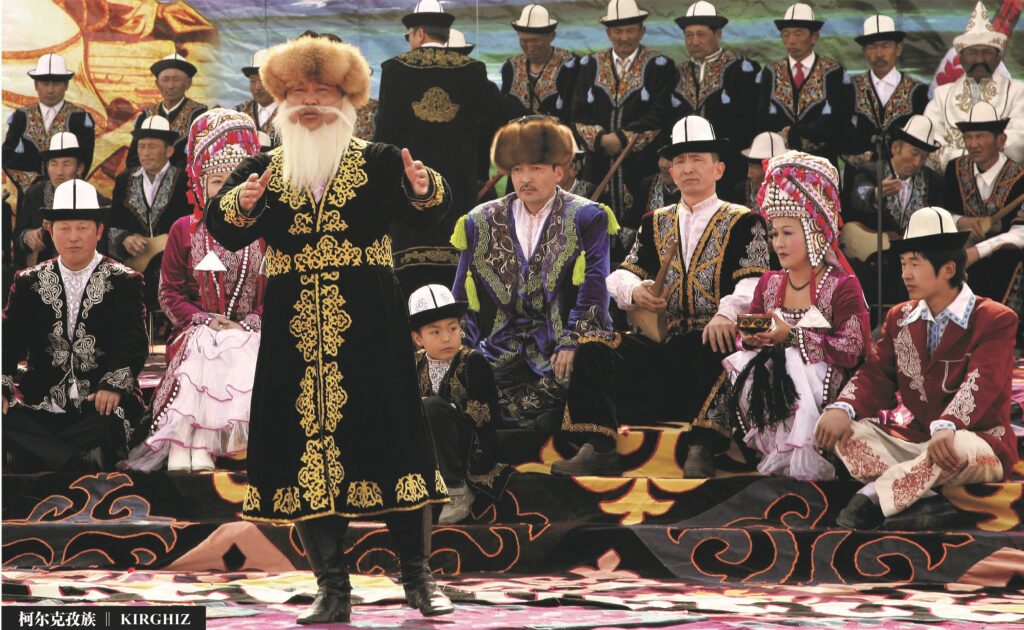
柯尔克孜族在国外又称吉尔吉斯族,在中国主要聚居于新疆维吾尔自治区西南部的克孜勒苏柯尔克孜自治州。过去柯尔克孜族信仰萨满教,现今大多信仰伊斯兰教。柯尔克孜人多戴下沿有一道黑布或黑平绒的小帽,冬季则戴皮帽。男子着绣白色花边的圆领衬衫,妇女多穿连衣带褶长裙,披色彩绚丽的金丝绒坎肩。(新华社发 陈鹏 摄)
The Kirghiz people is also known as the Kyrgyz people out of China. They mainly live in the Kizilsu Kirghiz Autonomous Prefecture in the southwest of the Xinjiang Uyghur Autonomous Region. In the past, the Kirghiz people believed in Shamanism, most of whom nowadays believe in Islam. The Kirghiz people usually wear a small cap with its lower edge trimmed with a black cloth or black velveteen, and a fur hat in winter. Men usually wear band collar shirts embroidered with white lace, and women usually wear pleated long skirts and colorful pleuche vests. (Photo by Chen Peng, Xinhua News Agency)
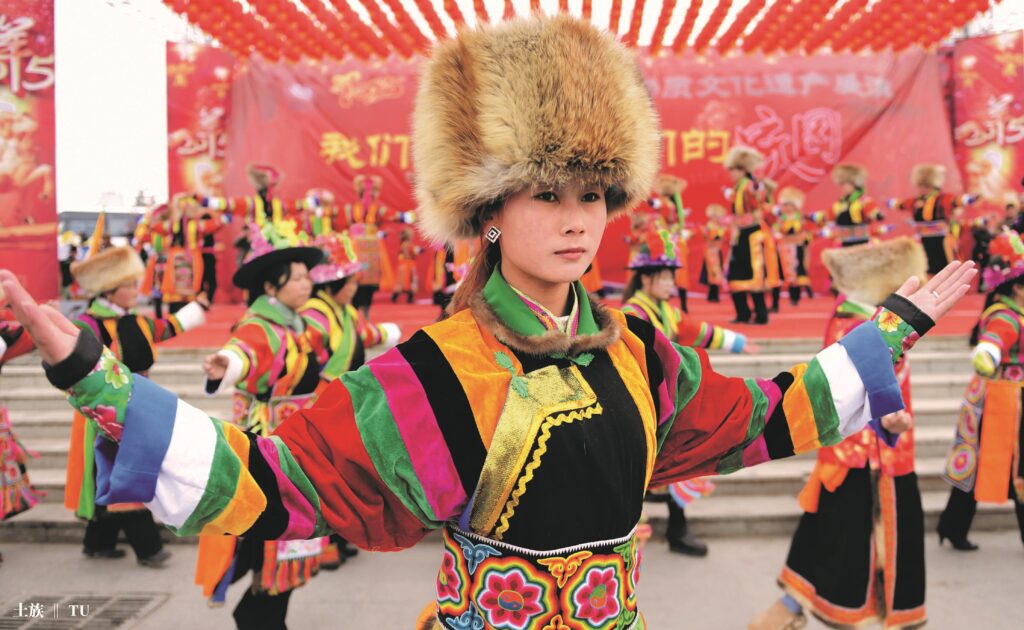
土族是中国人口较少的民族之一,主要聚居在青海互助土族自治县。土族传统信仰为佛教。土族的传统服饰色彩鲜艳,最有特色的是妇女的七彩花袖,由红、黄、绿、青、紫五色彩布拼制而成,戴各种“扭达”(头饰)。(新华社记者 张宏祥 摄)
The Tu people is one of the ethnic groups with a small population in China, who mainly lives in the Huzhu Tu Autonomous County, Qinghai Province, with Buddhism as its traditional religion. The traditional costumes of the Tu people are brightly colored, the most distinctive feature of which is the colorful flower sleeves for women. They are made of cloth in five colors, which consist of red, yellow, green, turquoise, and purple. Women usually wear various Niuda (a local headwear). (Photo by Zhang Hongxiang, journalist of Xinhua News Agency)
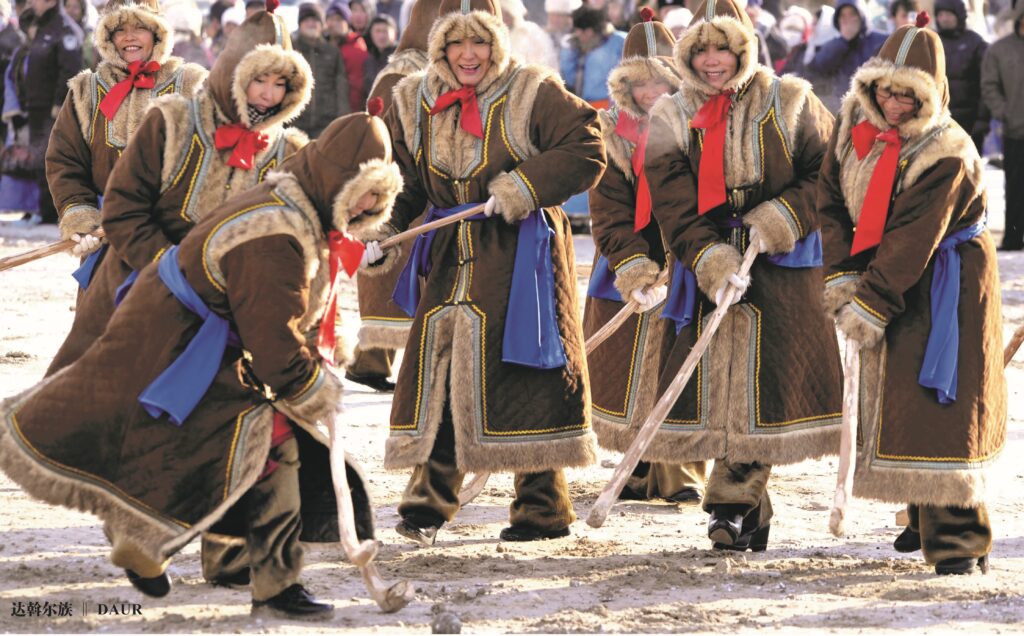
达斡尔族主要分布于内蒙古自治区莫力达瓦达斡尔族自治旗、黑龙江省齐齐哈尔市梅里斯达斡尔族区、鄂温克族自治旗一带。“哈拉”是达斡尔族的氏族组织,它是以父系血缘关系为纽带而结成的社会集团。达斡尔族是中国北方农牧文化较为发达的少数民族之一,农牧并举,渔猎兼营。达斡尔族能歌善舞,民间音乐有山歌、对口唱和舞词等多种形式。(新华社记者 李欣 摄)
The Daur people are mainly distributed in the Molidawa Daur Autonomous Banner in Inner Mongolia Autonomous Region, the Meris Daur District of Qiqihar City and the Ewenki Autonomous Banner in Heilongjiang Province. Hala is the name of a Daol clan, which is a social group formed by the patriarchal blood relationship. The Daur people is one of the ethnic minorities with relatively developed agricultural and animal husbandry culture in northern China, who are focused on agriculture, animal husbandry, fishing, and hunting. The Daur people are good at singing and dancing, and their folk music is with many forms such as mountain songs, duikou singing (duo singing in turn), and wording dance. (Photo by Li Xin, journalist of Xinhua News Agency)
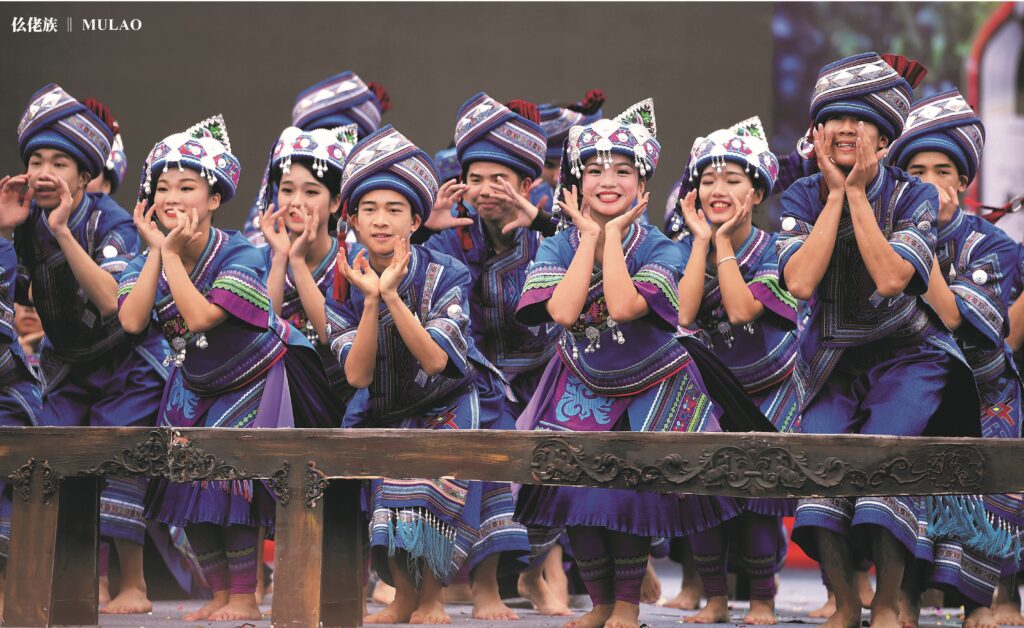
仫佬族主要分布在广西壮族自治区,贵州省也有分布。仫佬族聚族而居,同一宗族的人往往居住在同一村寨内。仫佬族的服装尚深青色,风格素朴简约。男子穿对襟上衣,搭配长裤,女子穿滚边的大襟短衣,宽身阔袖,配绣花筒裙或长裤束青布围裙,喜欢佩戴各种金银饰品。(新华社记者 陆波岸 摄)
The Mulao people are mainly distributed in the Guangxi Zhuang Autonomous Region, and also live in Guizhou Province. The Mulao people live in clans, and people in the same clan often live in the same village. Clothes in dark blue color are favored by the Mulao people, with a simple and plain style. Men usually wear long trousers and duijincoats, with the left side of the front closure jointing but not overlapping with the right side. Women usually wear short, piped coats with a large front and wide sleeves, embroidered tube skirts or trousers, and blue cloth aprons. They like wearing a variety of gold and silver accessories. (Photo by Lu Bo’an, journalist of Xinhua News Agency)
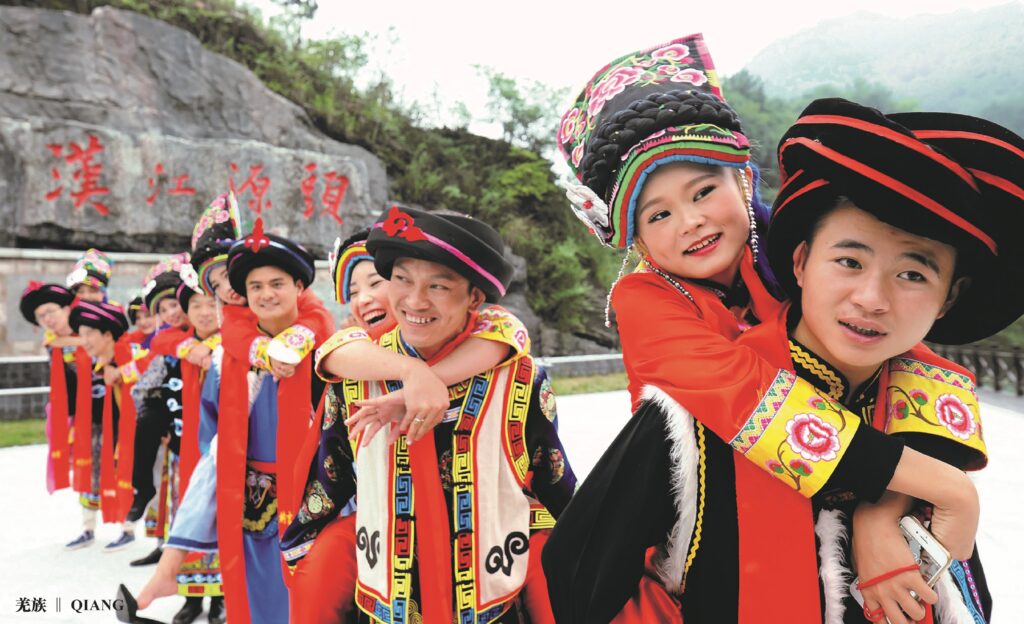
羌族是中国西部的一个古老民族,主要分布在四川省阿坝藏族羌族自治州,被称为“云朵上的民族”。羌族民间工艺别具一格,以挑花、刺绣最为出色。羌族服饰朴素美观,男女都包头帕,穿形似旗袍的棉布或锦缎长衫。中老年人多着单一的蓝、黑色服装,年轻姑娘的服装则大多色彩艳丽。(新华社发 黎德华 摄)
The Qiang ethnic is an ancient people in western China, who is mainly distributed in the Aba Tibetan and Qiang Autonomous Prefecture of Sichuan Province and is known as “the people above the clouds”. The Qiang folk crafts are unique, of which the cross-stitch work and embroidery are the best features. The Qiang costumes are simple and beautiful. Both men and women wear heads carves and cotton or brocade gowns that resemble cheongsam. Middle-aged and elderlies usually wear clothing in single blue and black color, while most of the young girls’ clothes are colorful. (Photo by Li Dehua, Xinhua News Agency)
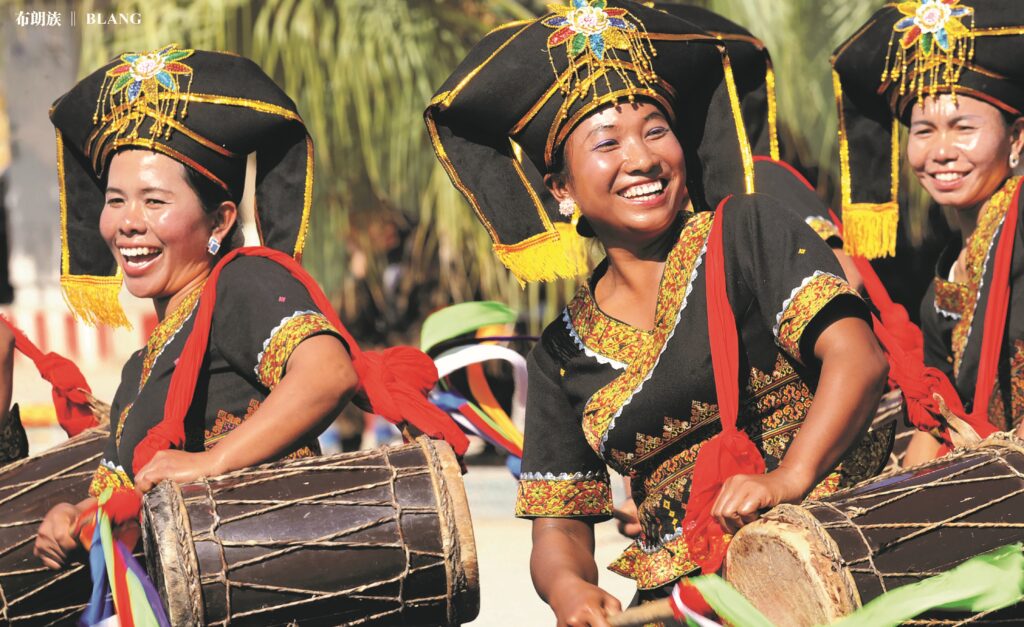
布朗族主要分布在云南省西部、西南部沿边地区的群山和森林之中,长久以来延续着丰富的民族文化,体现在民族语言、服饰、歌舞、风俗习性等方面。布朗族的服色以黑、青色为主,青年男子缠头巾,老年男子喜欢蓄长发,将发辫盘于头顶,包白色头巾;布朗族妇女均挽髻于顶,年轻姑娘多用鲜艳夺目的丝线、毛线编织彩穗、绒球花装饰耳塞。(新华社记者 陈海宁 摄)
The Blang people mainly live in the mountains and forests in the border areas in western and southwestern Yunnan Province. Its rich culture has long been passed through continuously, including ethical language, costumes, songs, dance, customs and habits. The Blang people usually wear black and blue costumes. Young men wear headscarves. Elderlies like to grow long hair and braid it or top of their heads covered with white headscarves. Women all bun their hair on top of their heads, and young girls use thread spikes and pompoms made of colorful silk and woven thread and to decorate their earrings. (Photo by Chen Haining, journalist of Xinhua News Agency)
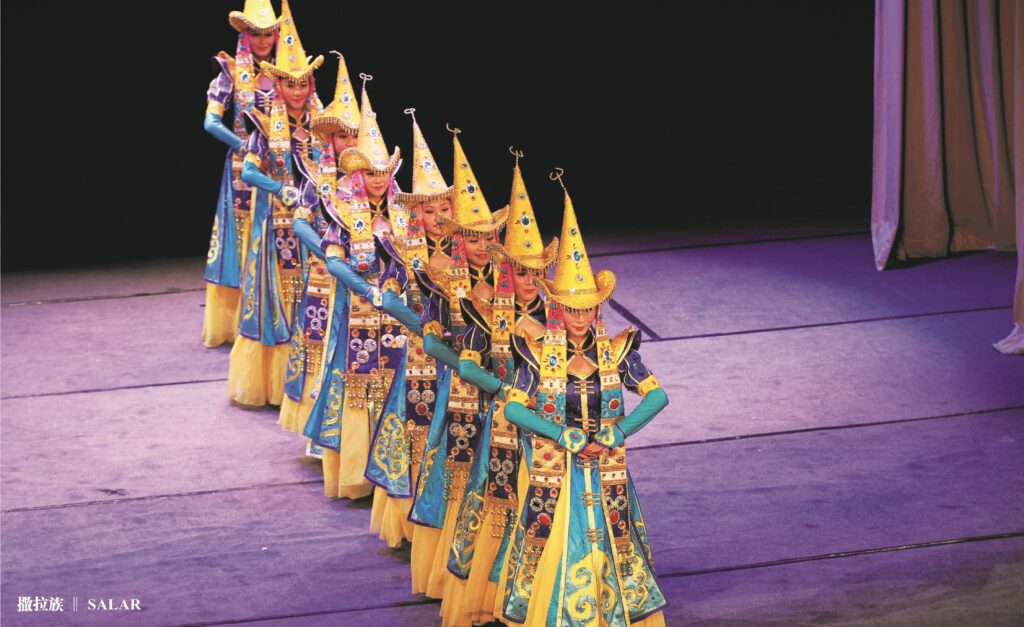
撒拉族主要聚居在青海省、甘肃省,在新疆地区也有零星分布。撒拉族在社会生活、风俗习惯等方面受伊斯兰教影响较深。撒拉族男子头戴无檐的白色、黑色六牙帽或小圆帽,身着白布汗褡青夹夹;妇女戴“盖头”,喜欢色泽艳丽的大襟花衣服,多佩戴长串耳环、戒指、手镯、串珠等手饰。(新华社记者 黄灵 摄)
The Salars mainly live in Qinghai Province and Gansu Province, and sporadically in Xinjiang. The Salar people are deeply influenced by Islam in social life, customs and habits. The Salar men wear brimless white or black Liuya caps or small round hats, and white, short coats with blue vests. Women like brightly colored, flowered coats with a large front, and usually wear Gaitou (a special headscarf), long strings of earrings, rings, bracelets, beads strings, and other hand accessories. (Photo by Huang Ling, journalist of Xinhua News Agency)
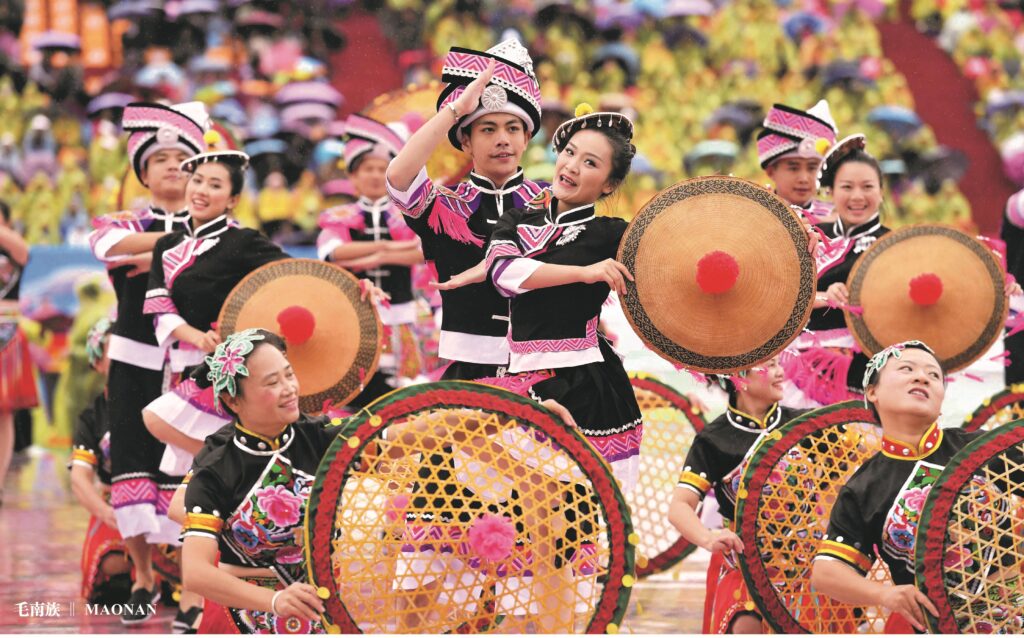
毛南族主要聚居在广西环江县的上南、中南、下南山区等地。毛南族形成了独特奇异的风俗习惯,也创造了绚丽多彩的文化艺术。其服饰与附近的壮族、仡佬族相似,男女都穿着大襟和对襟衫,男装称为五扣衣,不镶花边;女装最大的特点是镶有三道黑色花边的左开襟上衣和裤子,姑娘们还系上一小块绣着美丽花纹图案的长方形的围腰。(新华社记者 周华 摄)
The Maonan people mainly live in the Shangnan, Zhongnan, and Xianan mountainous areas in Huanjiang County, Guangxi Province. The Maonan people has formed unique customs and habits, and colorful culture and art. Its costumes are similar to their neighboring Zhuang people and Mulao people and both men and women wear coat with a large front or with duijin (the left side of the front closure jointing but not overlapping with the right side). Men’s clothing is called five-button clothing, without lace, while the most outstanding features of women’s clothing are their three parallel, black laces decorated on their trousers and their left-opened tops. Young girls also wear a small rectangular waist band embroidered in beautiful patterns. (Photo by Zhou Hua, journalist of Xinhua News Agency)
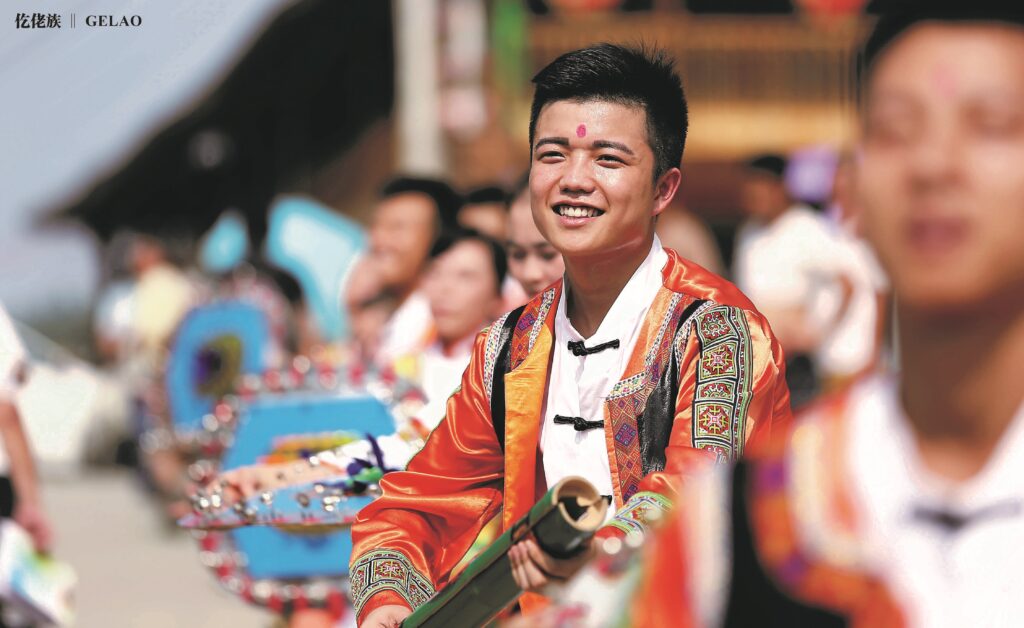
仡佬族大多集中聚居在贵州省北部的务川、道真两个仡佬族苗族自治县和石阡县。因生活在崇山峻岭之中,仡佬族的衣食住行与山林息息相关,依旧延续着奉祀竹王、蛮王老祖、山神的习惯。仡佬族的传统服装为家织麻布染青蓝二色制成,男者着无领长衫,抄襟,长至膝下;女衣短装,抄襟,缀花边。(新华社发)
Most of the Gelao people are living in Wuchuan and Daozhen, the two Gelao and Miao Autonomous Counties and Shiqian County in the northern part of Guizhou Province. Due to its living in the mountains, the Gelao people’s clothing, food, shelter, and transportation are closely related to the mountains and forests. They still continue their worship of gods, such as the Bamboo King, the Ancestral King, and mountain gods. The traditional Gelao costumes are made of home-woven linen dyed in green and blue. Men wear collarless gowns, with Chaojin (a special type of coat front), down to below the knee. Women wear short coat, with Chaojin, decorated with lace. (Xinhua News Agency)
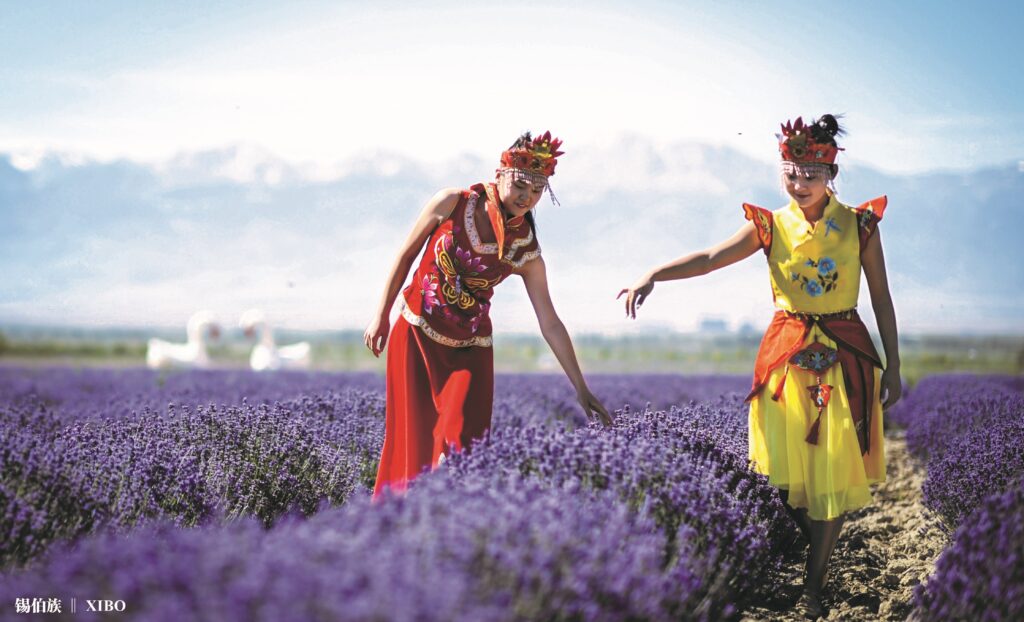
锡伯族是我国少数民族中历史悠久的古老民族,主要分布在东北地区、新疆、内蒙古等地。锡伯族传统信仰萨满教、佛教,主要崇奉“喜利妈妈”和保护牲畜的“海尔汗玛法”。锡伯族的传统服饰吸收了蒙、满、汉等民族服饰的优点,男子着蓝、青、灰、棕色长袍,脚蹬厚底鞋,便于骑马;妇女喜穿各色花布和方格布旗袍(多滚边)、绣花鞋、坎肩等。(新华社记者 赵戈 摄)
The Xibo people is an ethnic group with a long history among ethnic minorities in China, who mainly lives in the Northeast China, Xinjiang and Inner Mongolia Autonomous Region. The traditional religions of Xibo people are Shamanism and Buddhism, and they mainly worship the Haili Mamma and the Haier Khan Mafa that protects livestock. The traditional costumes of the Xibo people absorb the features of the costumes of Mongolian, Manchu, Han and other peoples. Men wear robes in blue green, gray, and brown, with thick bottom shoes for riding horses, and women like to wear a variety of cheongsams (mostly piped) made in colorful cloth and gingham, embroidered shoes, and vests, etc. (Photo by Zhao Ge, journalist of Xinhua News Agency)
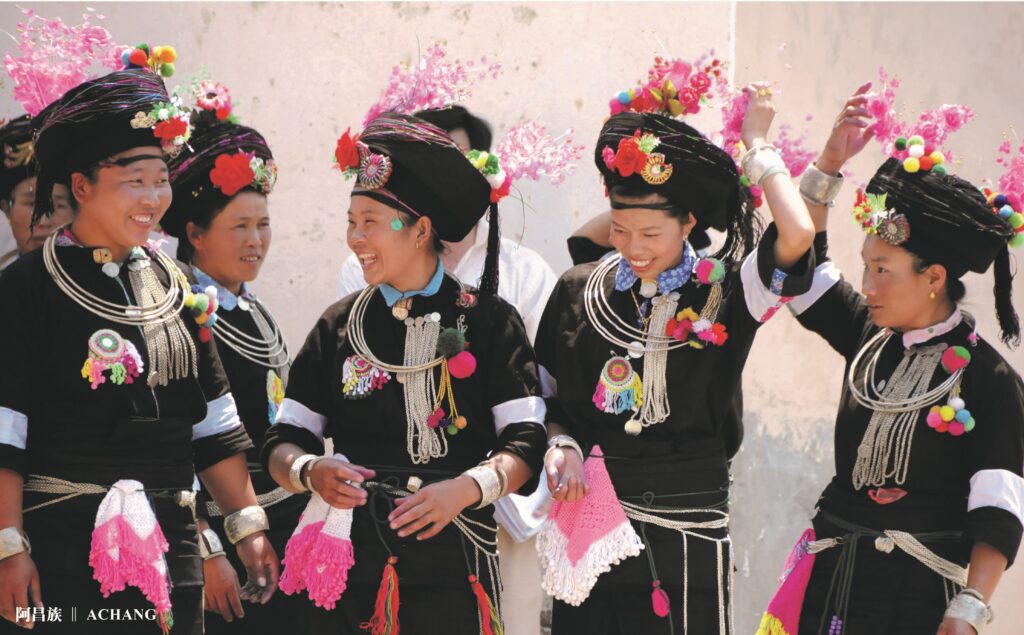
阿昌族是云南特有的、人口较少的少数民族之一,主要分布于云南省德宏傣族景颇族自治州。阿昌族制造的铁器极负盛名,以“户撒刀”著称于世。阿昌族传统服饰别具风格,男子一般穿蓝色、白色或黑色的对襟上衣,黑色长裤;妇女的服饰因地而异,少女的传统服饰是浅色对襟上衣,下着深色裤子。发辫挽于头顶,发辫上插花。(新华社发 何璐璐 摄)
The Achang people is one of the less populous ethnic minorities living in Yunnan’s only, who is mainly distributed in the Dehong Dai and Jingpo Autonomous Prefecture in Yunnan Province. The ironware made by the Achang people is extremely famous, of which the Husa knife is well known. The Achang traditional costumes are unique. Men usually wear blue, white or black duijin coat with the left side of the front closure jointing but not overlapping with the right side, and black trousers, while women’s clothing varies from place to place. The traditional costumes for girls are light-colored duijin coats with the left side of the front closure jointing but not overlapping with the right side and dark trousers. Girls pin their braids on the top of the head with flowers. (Photo by He Lulu, Xinhua News Agency)
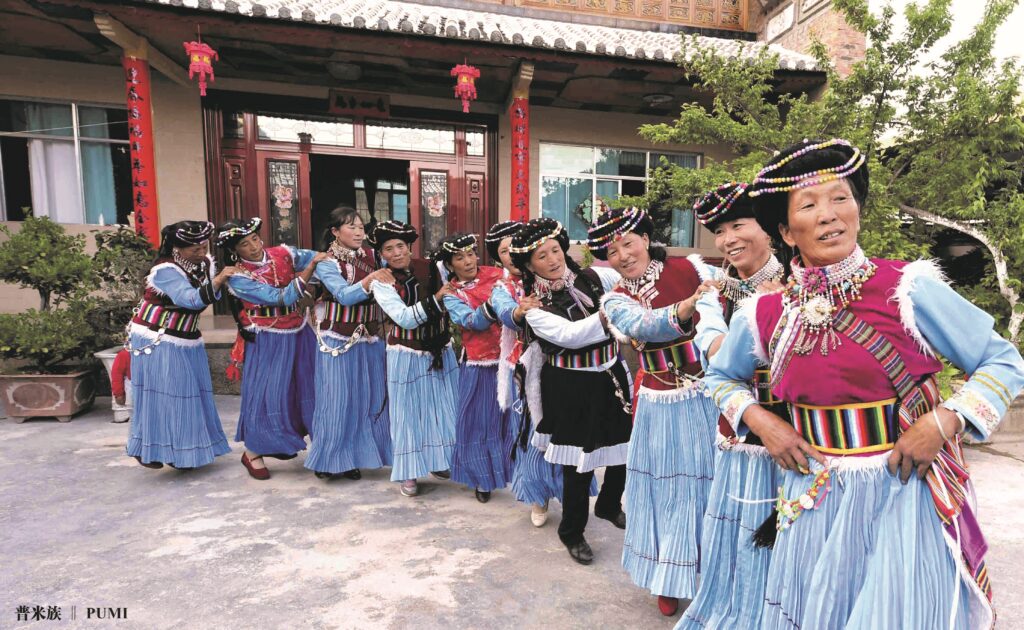
普米族主要分布于云南西北部和四川西南部。普米族原是游牧民族,擅长饲养和放牧,传统手工业包括纺织、皮革、铁器制造、酿酒、榨油、竹器編织等,其中宁蒗地区的木漆碗制作精美,远近闻名。普米族的服饰以宁蒗地区的传统保持较多,女子穿镶边的大襟外衣,用巾包头,男子穿麻布短衣、宽大长裤。(新华社记者 杨宗友 摄)
The Pumi people are mainly distributed in the northwestern Yunnan and southwestern Sichuan. The Pumi people are originally nomadic people, who are good at breeding and grazing, and their traditional craft industry includes textiles, leather and iron making, winemaking, oil extraction, and bamboo weaving. The painted wood bowls in Ninglang area are well-made and well-known. The Pumi costumes are mostly preserved in the Ninglang region. Women wear piped coats with a large front and headscarf, and men wear linen short coats and loose trousers. (Photo by Yang Zongyou, journalist of Xinhua News Agency)
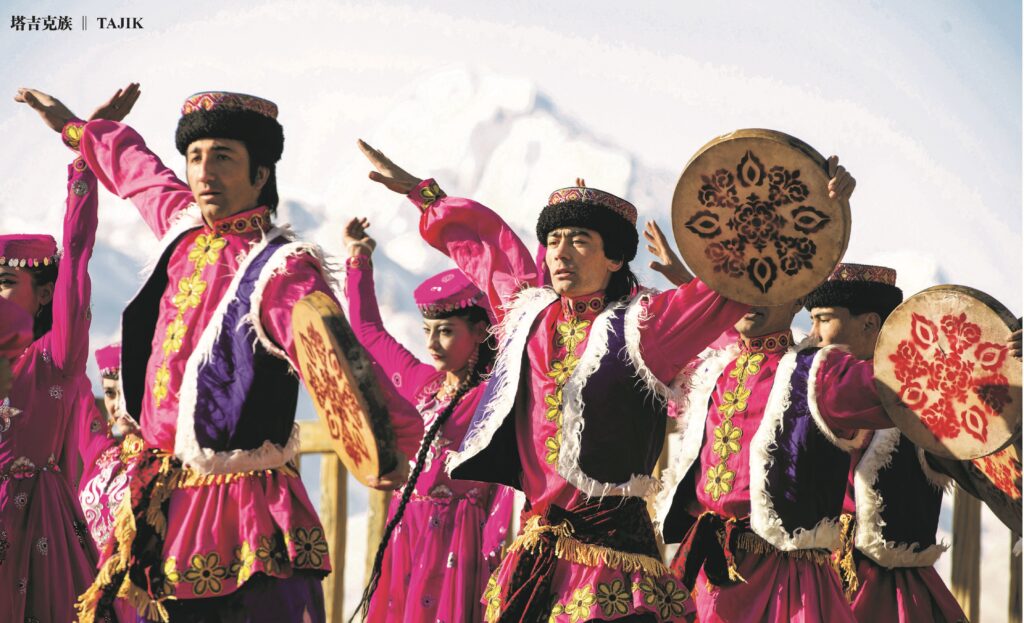
中国境内的塔吉克族主要聚居于新疆塔什库尔干塔吉克自治县,传统信仰为伊斯兰教。塔吉克族人能歌善舞,以鹰舞最为著名。塔吉克族成年男子一般戴黑绒圆高统“吐马克”帽,帽上绣有花纹,帽里用优质黑羔皮缝制。妇女服饰艳丽,一般着连衣裙及长裤,戴厚实而绣满图案的圆顶帽“库勒塔”,这是塔吉克妇女区别其他民族妇女的重要标志。(新华社记者 江文耀 摄)
The Tajik people in China mainly live in the Taxkorgan Tajik Autonomous County in the Xinjiang Uyghur Autonomous Region, whose traditional belief is Islam. The Tajik people are good at singing and dancing, with eagle dance as the most famous one. Tajik adult men usually wear a black velvet, high-grade Tumake hat embroidered with patterns, and the inner part is sewn with high-quality black lambskin. Women’s costumes and accessories are splendidly colorful. They usually wear one piece dresses and trousers, and Kuleta, a thick and embroidered dome hat, which is an important symbol for Tajik women to be distinguished from those of other ethnic groups. (Photo by Jiang Wenyao, journalist of Xinhua News Agency)
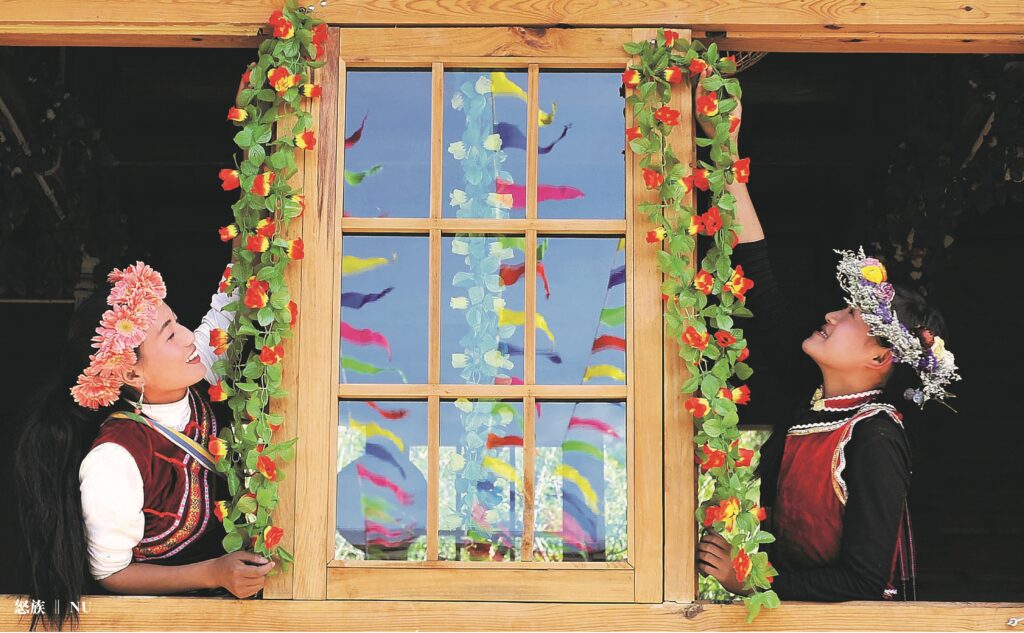
怒族主要分布在云南省怒江傈僳族自治州,传统信奉原始宗教,认为万物有灵。因生活在怒江大峡谷一带,危岩耸立、江水滔滔,怒族人民只有依靠“溜索”这种古老的渡江工具往来飞渡。怒族男女服饰多为麻布质地,妇女喜欢用珊瑚、玛瑙、贝壳、银币等做成漂亮的头饰和胸饰。(新华社记者 邹峥 摄)
The Nu people are mainly distributed in the Nujiang Lisu Autonomous Prefecture of Yunnan Province, who traditionally believe in primitive religion and believe that everything is with its own spirit. Because of living in the Nujiang River Grand Canyon with precipitous rocks and roaring water, the Nu people can only rely on Liusuo, an ancient rope instrument to cross the river from the above. Men and women of Nu people usually wear linen clothes, and women like to use coral, agate, shells, silver coins and so on to make beautiful headwear and chest ornaments. (Photo by Zou Zheng, journalist of Xinhua News Agency)
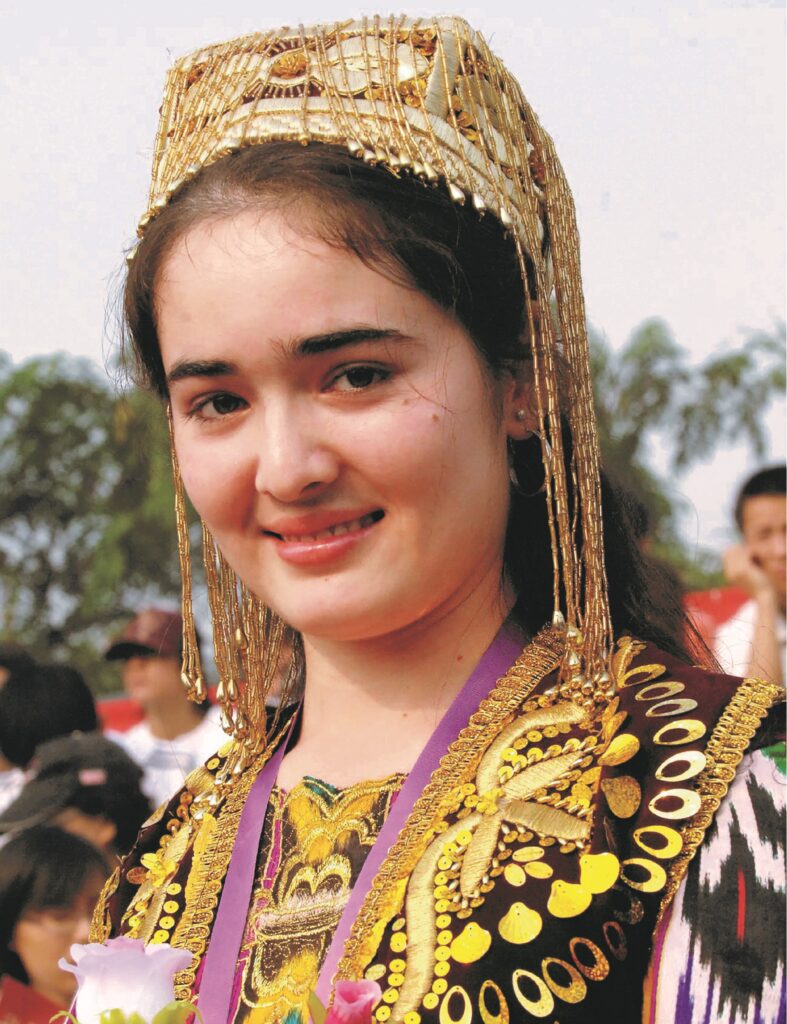
境外同源称乌兹别克族。中国境内的乌孜别克族散居在新疆维吾尔自治区许多县、市,其服饰尤其独特的民族风格,男女都佩戴各式各样的硬壳小花帽朵帕,男子一般穿带花纹的长衫,妇女着连衣裙“魁钠克”,宽大多褶,颜色艳丽。乌孜别克族人擅歌舞,传统的手鼓舞独具特点。(新华社记者 沈桥 摄)
The Uzbek people are distributed from both China and abroad with same origin, those of which in China are scattered in many counties and cities in the Xinjiang Uyghur Autonomous Region. Their costumes are with special and unique Uzbek style, and both men and women wear a variety of hard-shelled bonnets. Men usually wear patterned gowns and women wear Kuilak dresses whose features are wide, pleated, and in bright colors. The Uzbek people are good at singing and dancing, and their traditional tambourine dance is with unique feature. (Photo by Shen Qiao, journalist of Xinhua News Agency)
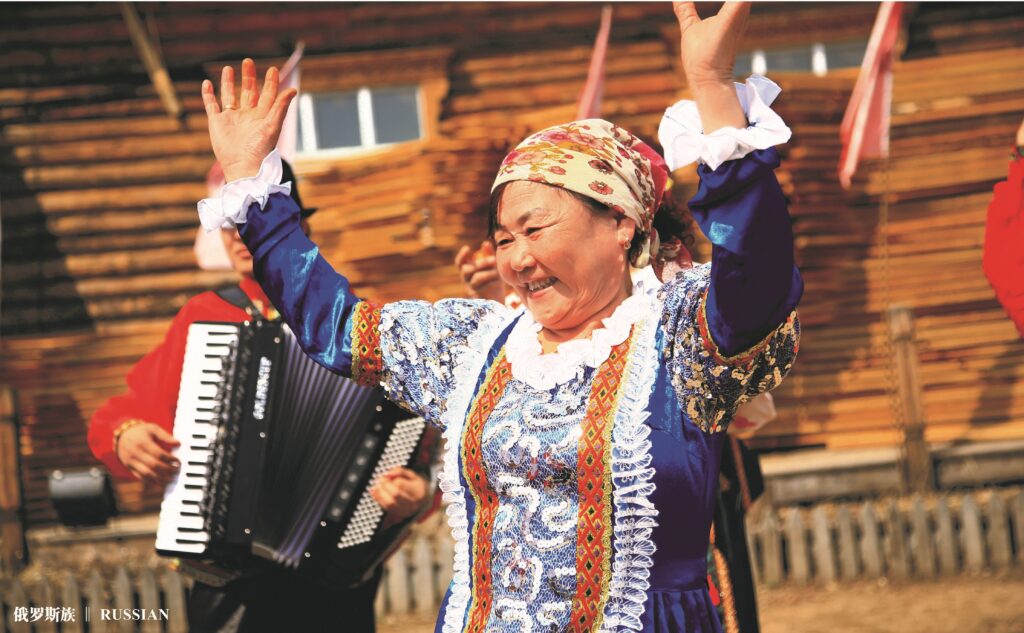
中国的俄罗斯族主要居住在新疆及内蒙古地区,传统信仰为东正教。中国的俄罗斯族是古代俄罗斯移民的后裔,经百年的文化交融,渐渐形成自己的民族特色,拥有风格独特的民族工艺和历史悠久的民间文学。其传统服饰男子多穿斜领麻布衬衫和呢子上衣,系腰带,下穿细腿长裤、长筒皮靴;妇女多穿领口带褶的粗麻布衬衫,外罩无袖长袍“萨拉凡”,或穿自织的毛织裙。(新华社记者 邹俭朴 摄)
The Russian people in China mainly live in Xinjiang and Inner Mongolia, with Orthodox as their traditional belief. The Russian people in China are descendants of ancient Russian immigrants. After hundreds of years of cultural integration, they have gradually formed their own characteristics, with unique ethnic craftsmanship and long-lasting folk literature. Men wear linen shirts with slanted collar, woolen coats, belts, thin trousers and long boots, while women wear burlap shirts with pleated collar, covered with sleeveless robes, the Sarafan, or self-woven woolen skirts. (Photo by Zou Jianpu, journalist of Xinhua News Agency)
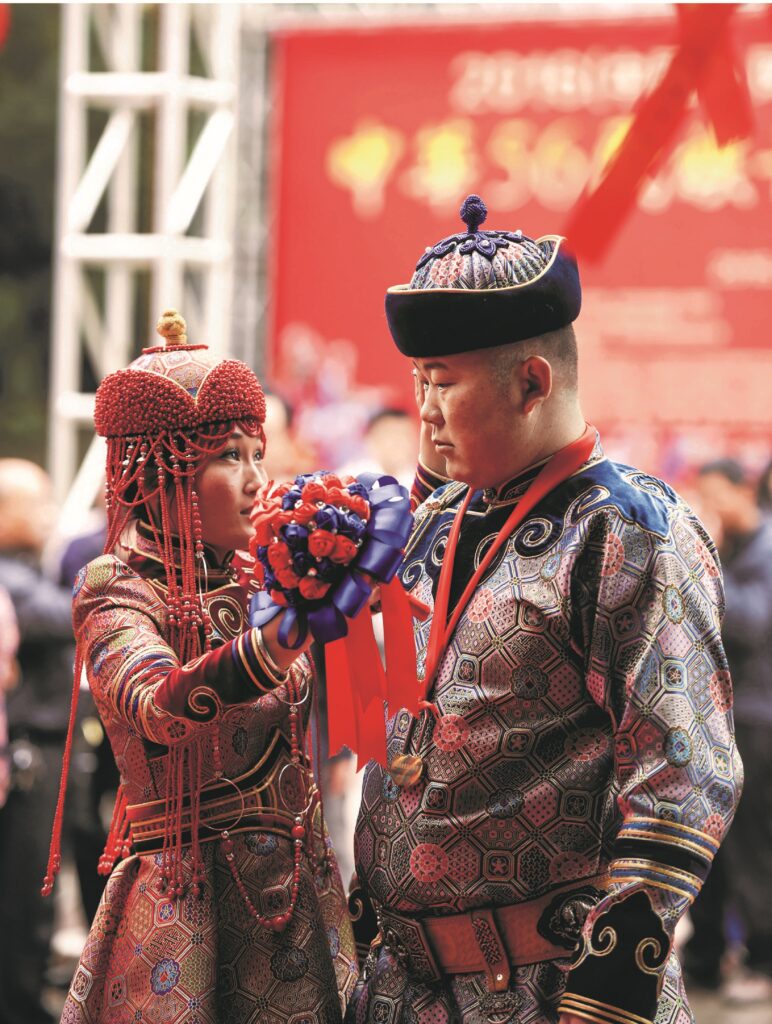
鄂温克族主要分布在内蒙古自治区,“鄂温克”的意思是“住在大山林中的人们”,他们从游牧发展到定居,一直从事着蓄牧业。鄂温克族民族文化丰富,拥有历史悠久的驯鹿文化,用桦树皮制作生活用具,其传统服装也以皮制为主,用孢皮、鹿皮、羊皮等制作冬季长袍、裤子、靴子、帽子、手套等,且各地鄂温克族的服饰各有特点。(新华社记者 毛思倩 摄)
The Ewenki people mainly live in the Inner Mongolia Autonomous Region. “Ewenki” means “people living in large mountain forests”. From nomadism to settlement, they have always been engaged in animal husbandry. Ewenki ethnic culture is rich with a long history of reindeer culture. Life utensils are made of birch bark. Its traditional costumes are mainly made of leather. Winter robes, trousers, boots, hats, and gloves are made of roe deer skin, deerskin and sheepskin, etc., and in different places the Ewenki costumes have their own characteristics. (Photo by Mao Siqian, journalist of Xinhua News Agency)
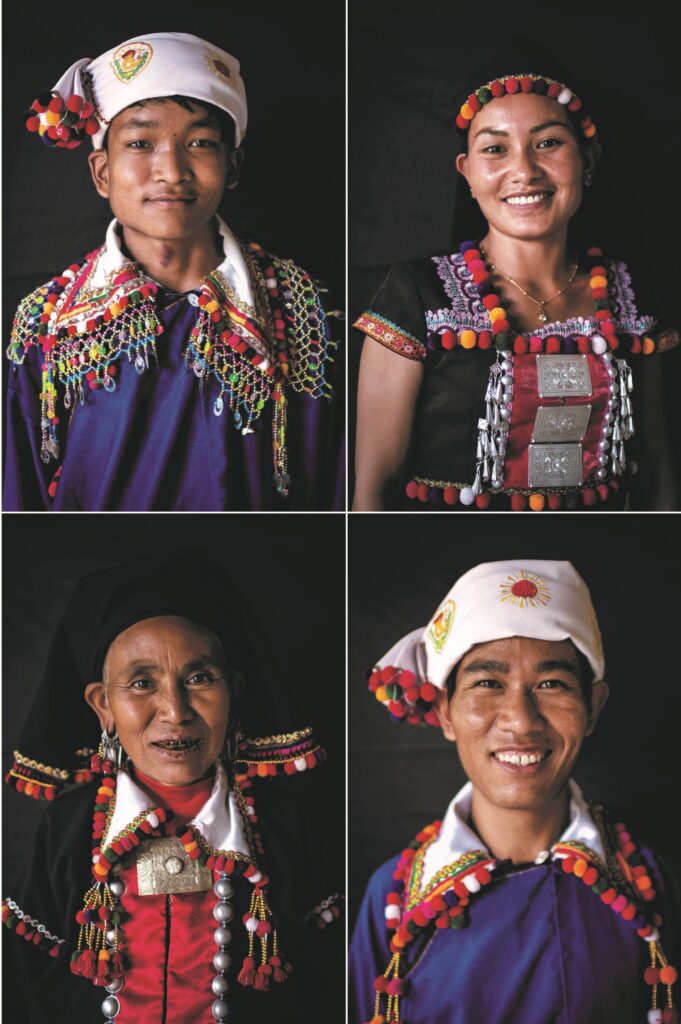
德昂族又称“崩龙族”,是中缅交界地区的少数民族,在中国主要分布在云南省德宏、保山、临沧等地,居住在依山而建的竹楼里。德昂族传统信仰为佛教,各村寨基本都有自己的佛寺。德昂族服饰具有浓厚的民族色彩,最引人注目的是妇女身上的腰箍,姑娘成年后,都要在腰部佩戴数个、甚至数十个藤编腰箍。(新华社记者 潘超越 摄)
The De’ang people, also known as the Benglong people, is an ethnic minority in the China-Burma border area. The De’ang people in China mainly live in bamboo buildings in mountains in Dehong, Baoshan, and Lincang in Yunnan Province. The traditional religion of the De’ang people is Buddhism, with its own Buddhist temple in almost every village. The De’ang costumes have a strong feature of its own, out of which the most striking one is the women’s waistband. When a girl grows up into an adult woman, she will wear several or even dozens of rattan waistbands around the waist. (Photo by Pan Chaoyue, journalist of Xinhua News Agency)
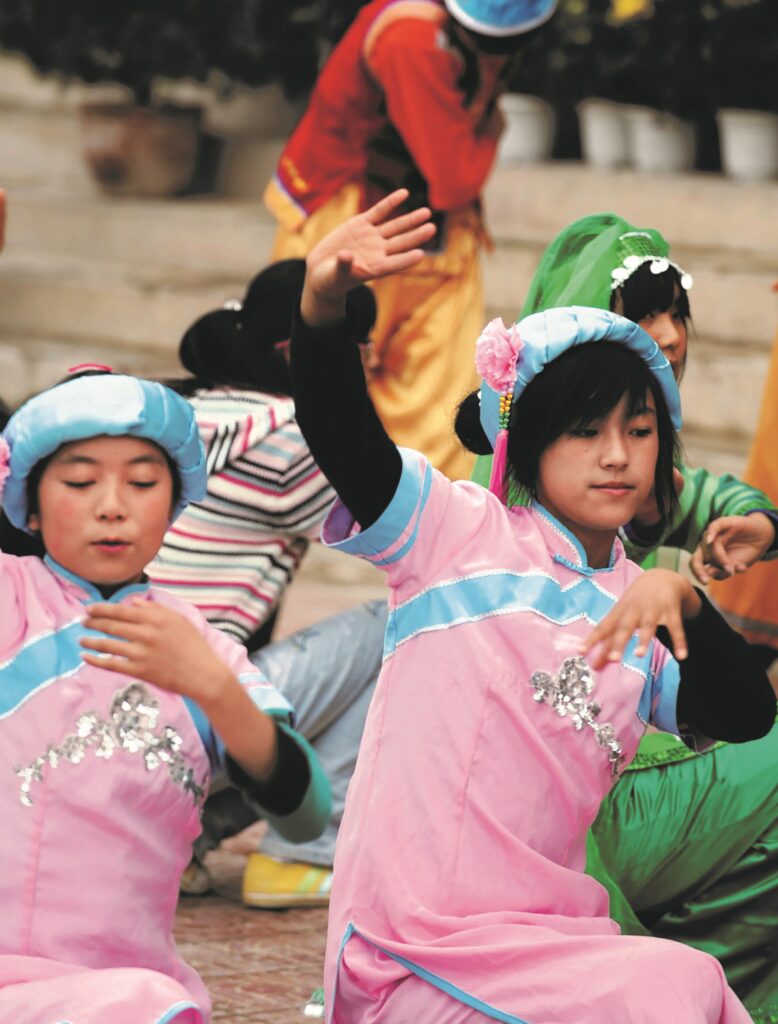
保安族是中国人口较少的民族之一,主要聚居在甘肃省临夏回族自治州,传统信仰为伊斯兰教。保安族由于过去与蒙古族相邻而居,其服饰与蒙古族相似,男子平时戴白色号帽,穿白色衬衣,黑色坎肩;女子一般戴盖头,穿色彩艳丽的右衽上衣,外套嵌有花边的坎肩。(新华社记者 张锰 摄)
The Bao’an ethnic group is one of the ethnic groups with a small population in China, who mainly lives in the Linxia Hui Autonomous Prefecture of Gansu Province with Islam as its traditional belief. Due to the fact they neighbored the Mongol people, their costumes are similar to theirs. Men usually wear white caps, white shirts, and black vests, while women generally wear hijabs, colorful coats with left front crossing over the right, and vests with embedded laces. (Photo by Zhang Meng, journalist of Xinhua News Agency)
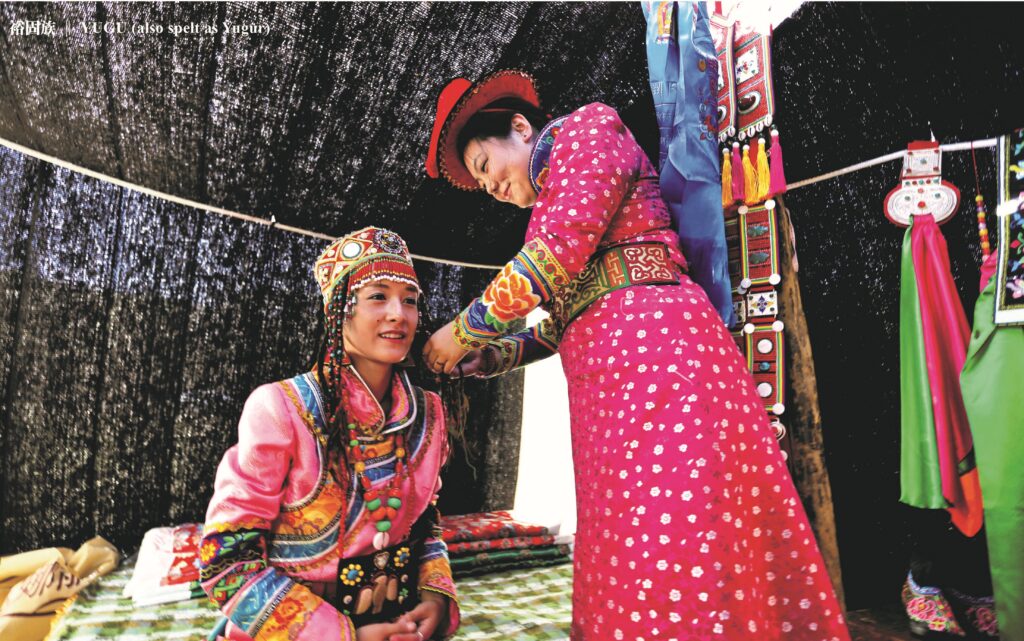
裕固族主要聚居在甘肃省,是以畜牧业为主的民族。裕固族源自唐代游牧在鄂尔浑河流域的回鹘,过去信仰萨满教和摩尼教,如今大多信仰佛教。裕固族男女都穿高领、大襟有衽的长袍,男子戴毡帽,束腰带,穿高统靴;女子穿下摆开衩,绣花边的高领长袍。(新华社发 王将 摄)
The Yugu (also spelt as Yugur) people mainly live in Gansu Province and is an ethnic group focused on animal husbandry. The Yugu people originated from the ancient nomadic Uyghur of the Tang Dynasty in the Orkhon River Basin, most of whom used to believe in Shamanism or Manichaeism but now in Buddhism. Yugu men and women wear high-necked robes with a large front. Men wear felt hat, belt, and high boots, and women wear high-necked robes with separated bottom hem and embroidered lace. (Photo by Wang Jiang, Xinhua News Agency)
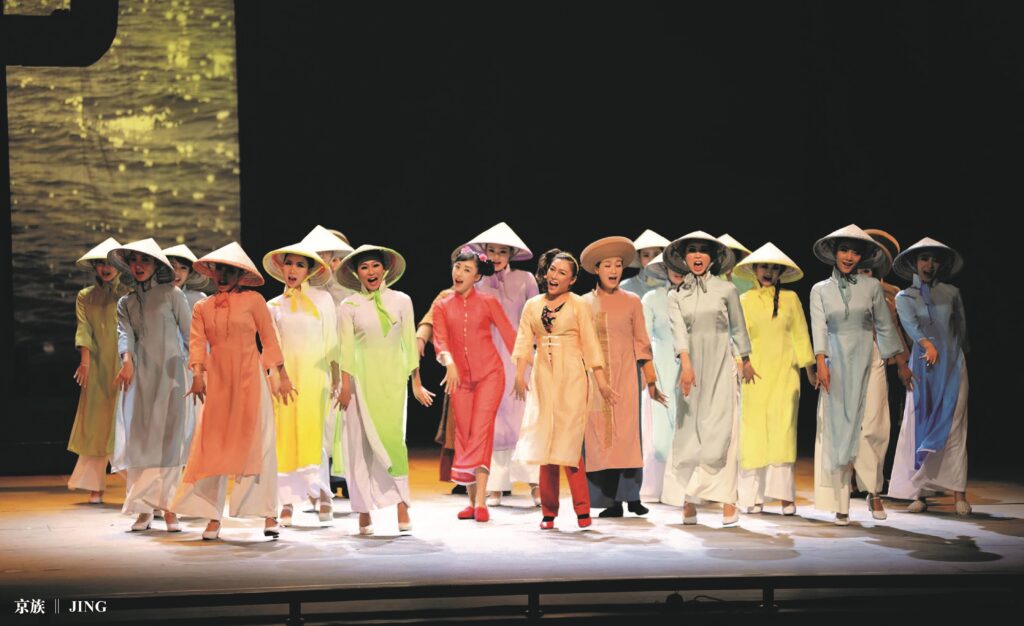
中国的京族主要分布在广西壮族自治区防城港市,是中国少数民族中人数较少的民族,其祖先过去由越南迁移过来,多以渔业为生。京族人的服饰简朴美观,身着长衫,头戴圆锥状的斗笠帽子,这是京族人的标志之一。(新华社发)
The Jing people of China is mainly distributed in Fangchenggang City of Guangxi Zhuang Autonomous Region, who is a less populated group in the ethnic minorities in China. Their ancestors migrated from Vietnam. Most of them depend on fisheries for a living. The Jing people’s costumes are simple and beautiful, and wearing long gowns and conical hats is one of the typical symbols of the Jing people. (Xinhua News Agency)
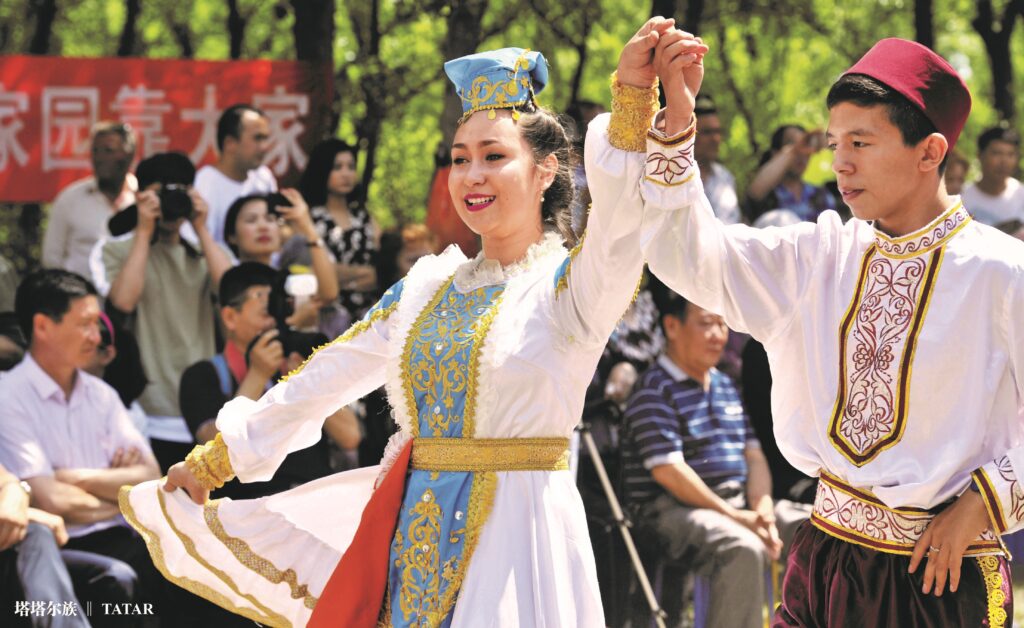
中国的塔塔尔族主要散居在新疆维吾尔自治区境内的天山北部地区,是中国少数民族中人口较少的民族之一。塔塔尔族妇女善刺绣,其服饰的特点便是在衬衣的领口、袖口、胸前绣着十字形、菱形等几何图案花纹。塔塔尔族传统信仰为伊斯兰教,传统节日主要有“肉孜节”、“古尔邦节”和“撒班节”。(新华社记者 胡虎虎 摄)
The Tatar people in China are mainly scattered in the northern part of the Tianshan Mountains in the Xinjiang Uyghur Autonomous Region, with a relatively less population among the ethnic minorities in China. The Tatar women are good at embroidering, whose clothing is with geometric patterns, such as crosses and diamonds, embroidered on the neckline, cuff and chest of their shirts. The Tatar traditional belief is Islam, with major traditional festivals the Eid al-Fitr, the Eid Adha, and the Saban Festival. (Photo by Hu Huhu, journalist of Xinhua News Agency)
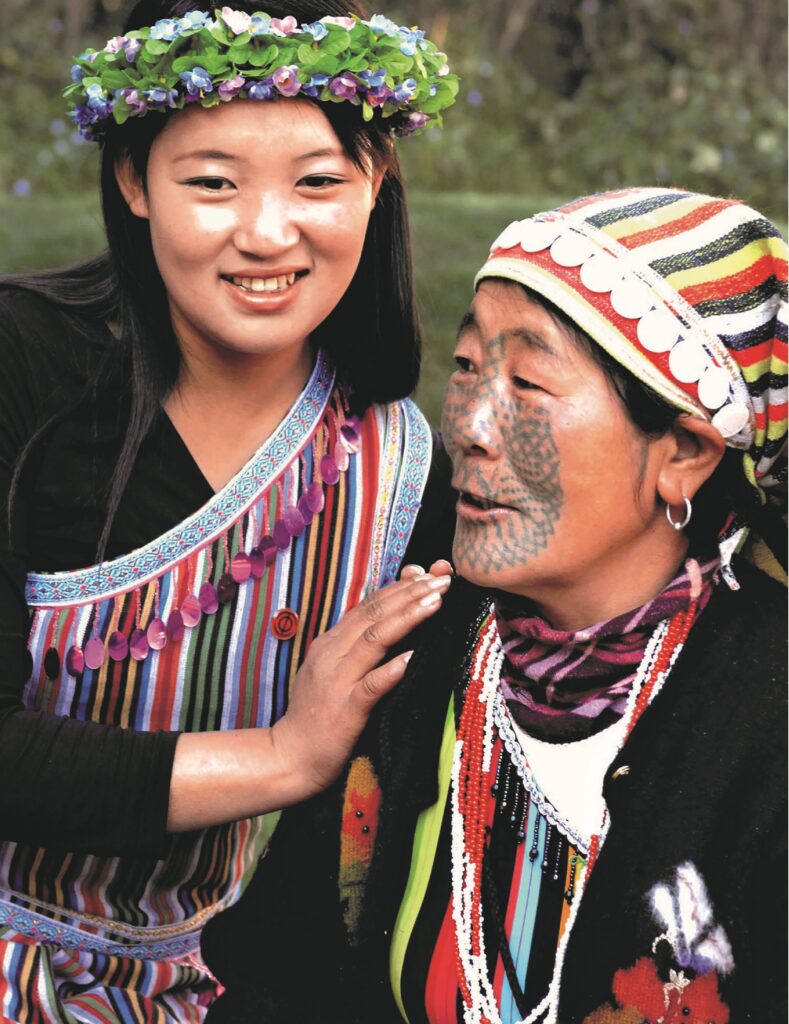
中国境内的独龙族主要分布在云南省独龙江峡谷两岸、北部的怒江两岸等地,其生产活动主要为农业、釆集和渔猎。独龙族的传统服装为一块五彩线织成的独龙毯,从左肩斜拉至胸前。独龙族男女均散发,少女有纹面的习惯。(新华社记者 周重要 摄)
The Dulong (also spelt as Derung) people in China are mainly distributed on the banks of the Dulong River Gorge in Yunnan Province and on the banks of the Nu River in the north, who mainly engage in agriculture, harvesting, and fishing. The traditional costume of the Dulong people is a unique Dulong carpet woven in threads in five colors, which could be pulled from the left shoulder across the chest. The Dulong men and women do not tie their hair, and girls have the customs of face tattooing. (Photo by Zhou Zhongyao, journalist of Xinhua News Agency)
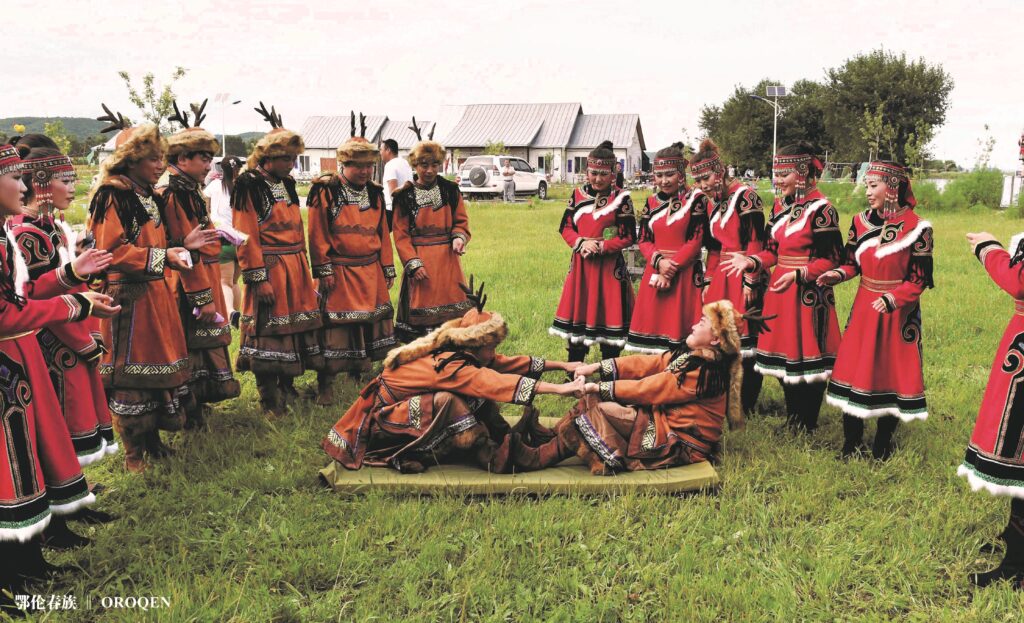
鄂伦春族主要分布在黑龙江和内蒙古,是中国东北部地区人口较少的民族之一。鄂伦春族是狩猎民族,因而生活习性体现了浓郁的狞猎文化,其服饰多以鹿、狍、犴皮制作,常用刺绣、补花云纹、鹿角纹等进行装饰。鄂伦春族传统信仰为萨满教,祖先、图腾崇拜传承至今。(新华社记者 王建威 摄)
The Oroqen ethnic group is mainly distributed in Heilongjiang and Inner Mongolia, and is one of the less populous ethnic groups in northeastern China. It is a hunting people. Thus its lifestyle reflects a strong hunting culture. Their costumes are mostly made of deerskin, roe deer skin, and lynx skin, and are often decorated with embroidery, cloud and antler lines. Their traditional belief is Shamanism, and the ancestors worship and totem worship have been passed down to today. (Photo by Wang Jianwei, journalist of Xinhua News Agency)
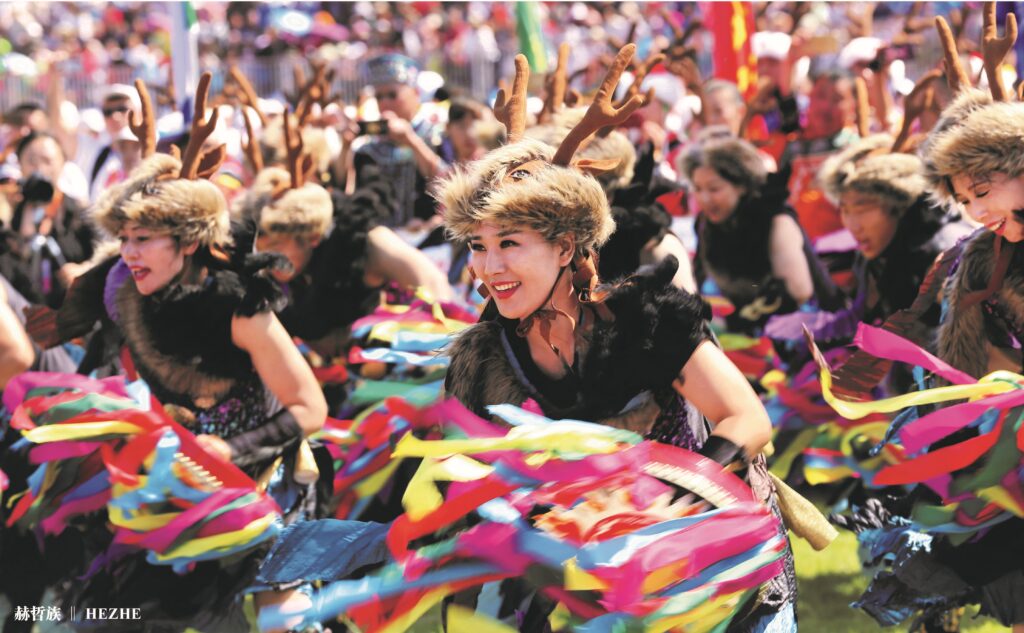
赫哲族主要分布在黑龙江省境内的三江平原和完达山余脉一带,是中国北方少数民族中惟一曾以渔猎为主的民族。口弦琴是赫哲人的传统乐器,其传统舞蹈也多模拟捕鱼、狩猎和战斗的场面。赫哲人的传统衣裤绣有云纹、几何纹、花朵、蝴蝶等,还把鱼、兽皮剪成各种图样染色补花。(新华社发 许丛军 摄)
The Hezhe people are mainly distributed in the Sanjiang Plain and the Wanda Mountain in the Heilongjiang Province. It is the only ethnic group who used to focus on fishing in the ethnic minorities in northern China. The Kouxianqin (a special chord) is a traditional instrument of the Hezhen people, whose traditional dance also simulates scenes of fishing, hunting, and fighting. The Hezhe people wear traditional clothing embroidered with cloud patterns, geometric patterns, flowers, butterflies, etc. They also cut fish and animal skin into various dyed patterns. (Photo by Xu Congjun, Xinhua News Agency)
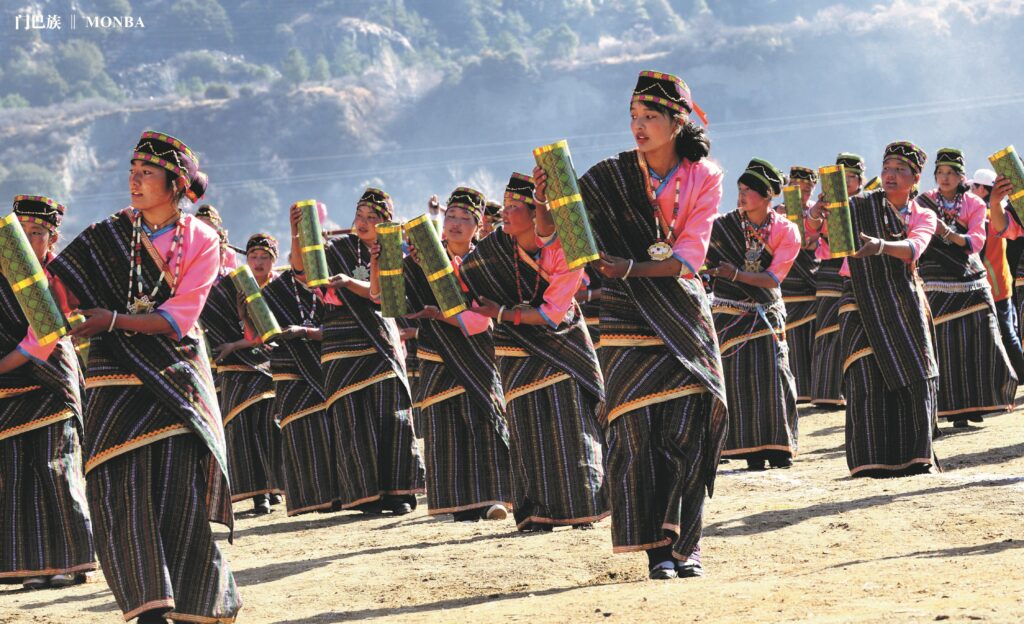
门巴族主要分布在西藏自治区东南部的门隅和墨脱地区。门巴族的生产方式主要有农业、牧业和手工业。门巴族的竹木器制作最为发达,门巴木碗久负盛名。门巴族女性服饰绚丽多彩,多以羊毛织成的氆氇呢染色制成。(新华社记者 格桑达瓦 摄)
The Monba people are mainly distributed in the Menyu and Metuk areas in the southeast of the Tibet Autonomous Region, who mainly engage in agriculture, animal husbandry, and traditional craft industry. The Monba people’s most developed industry is bamboo and wood crafts making, out of which the Monba wooden bowl has long enjoyed a high reputation. The Monba women’s costumes are colorful, most of which are made of dyed Puluni, a local wool suiting. (Photo by Kelsang Dawa, journalist of Xinhua News Agency)
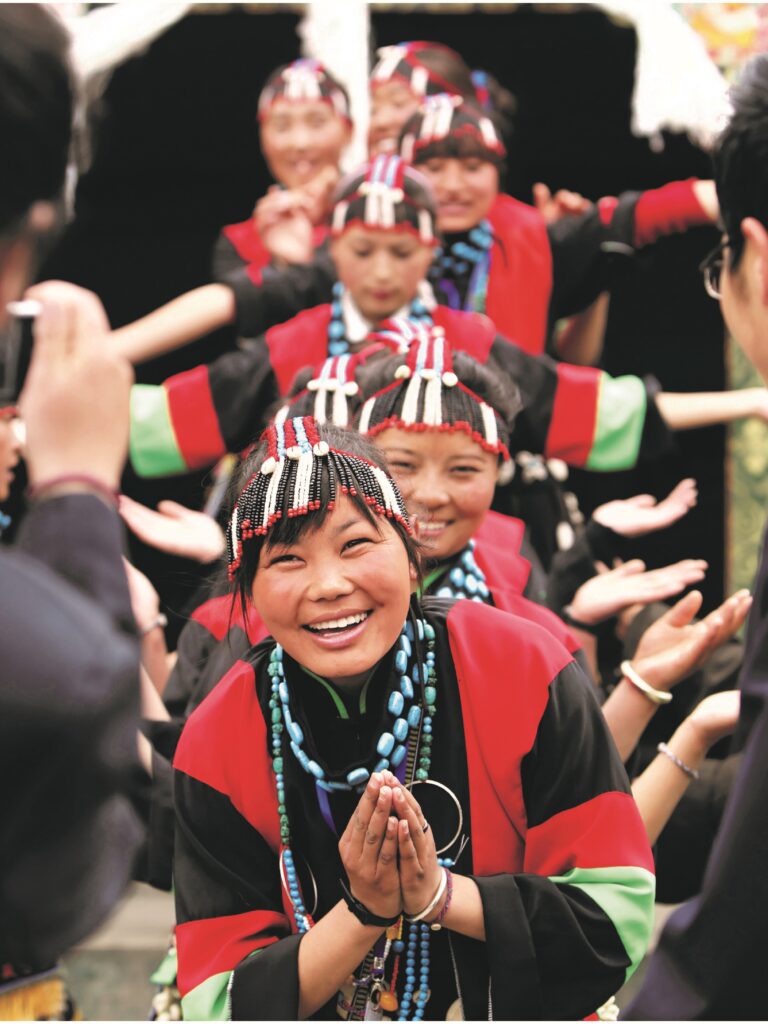
珞巴族主要分布在西藏自治区察隅至门隅之间的珞渝地区。珞巴人擅长狩猎,传统的男子服装也充分显示出山林狩猎的生活特点,身穿羊毛织成的黑色坎肩,背上披野牛皮。男女都喜欢佩戴饰品,尤其女性盛装时佩戴的饰品达十多斤重,都是每个家庭多年交换所得,是家庭财富的象征。(新华社记者 王迎 摄)
The Lhoba people are mainly distributed in the Loyu area between the Chayu and Menyu of the Tibet Autonomous Region. The Lhoba people are good at hunting, and the traditional men’s clothing also reflects the characteristics of hunting in the mountains and woods, with a black wool vest and a cowhide on the back. Men and women, especially women, like to wear accessories, weighting more than 5 kilograms when the owner dresses up. The accessories are family gains by exchange for many years and are a symbol of family wealth. (Photo by Wang Ying, journalist of Xinhua News Agency)
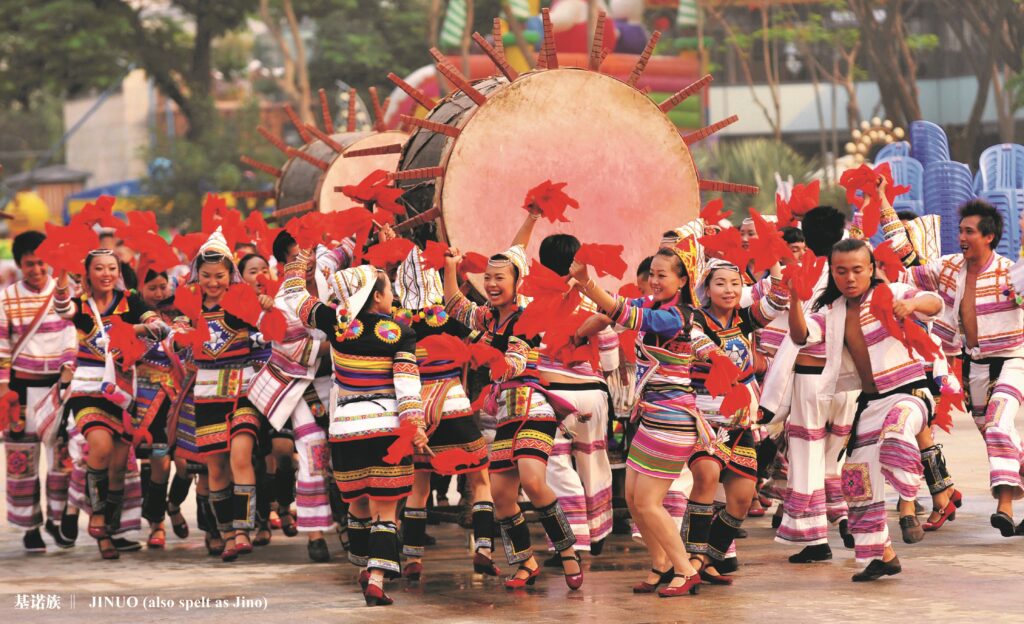
基诺族主要聚居于云南省西双版纳傣族自治州,是云南省人口较少的7个特有民之一。基诺族没有自己的文字,过去多以刻木、刻竹记数、记事。基诺族服饰简单古朴,喜欢穿自织的带有蓝、红、黑等彩条的土布衣服。(新华社记者 蔺以光 摄)
The Jinuo (also spelt as Jino) people mainly live in Xishuangbanna Dai Autonomous Prefecture in Yunnan Province, and is one of the seven unique ethnic groups in Yunnan Province with a small population. The Jinuo people do not have their own characters, and they used to engrave wood and bamboo for remembering numbers and issues. The Jinuo people wear simple costumes made in self-woven cloth with strips in blue, red, and black color. (Photo by Lin Yiguang, journalist of Xinhua News Agency)
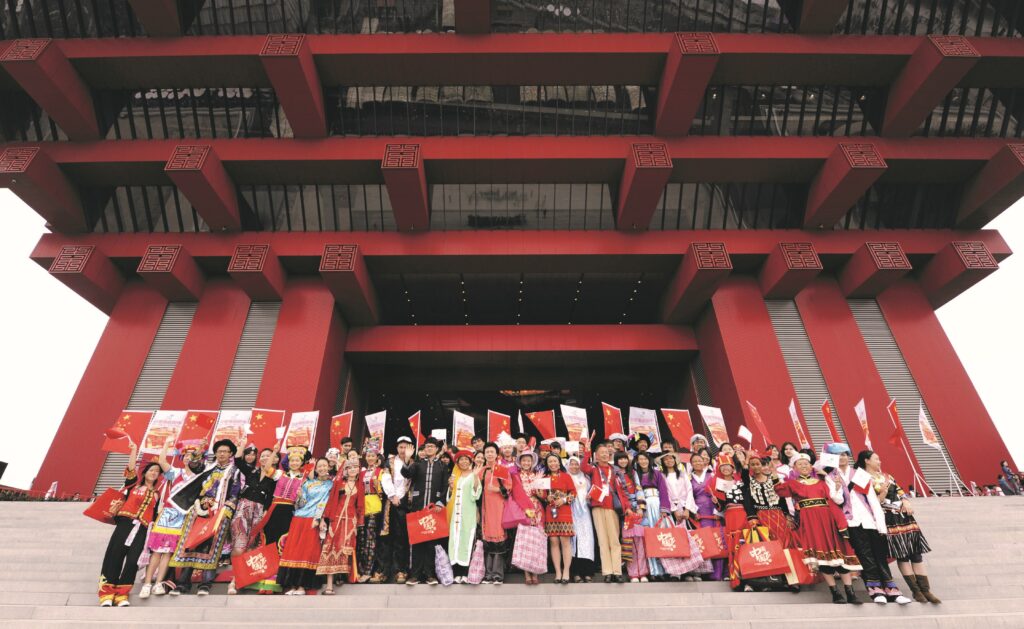
中国五十六个民族 (新华社记者 郭磊 摄)
The 56 ethnic groups in China. (Photo by Guo Lei, journalist of Xinhua News Agency)
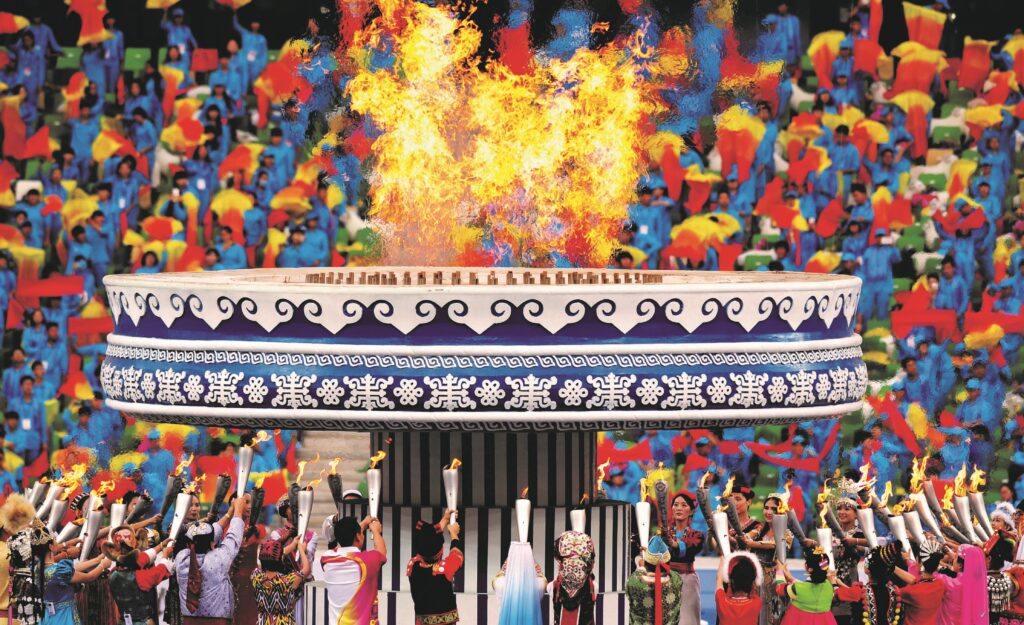
中国五十六个民族 (新华社记者 连振 摄)
The 56 ethnic groups in China. (Photo by Lian Zhen, journalist of Xinhua News Agency)
Facebook: China Cultural Center in Stockholm
https://www.facebook.com/China-Cultural-Center-in-Stockholm-110983273921638
Instagram: chinaculturalcenterinstockholm
https://www.instagram.com/chinaculturalcenterinstockholm/
Youtube: China Cultural Center in Stockholm
https://www.youtube.com/channel/UCYqOYwuQtyTHC-iMNdfExsw
Tik Tok: cccinstockholm
@cccinstockholm
